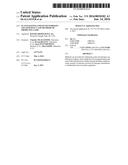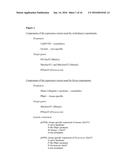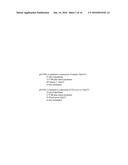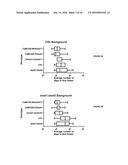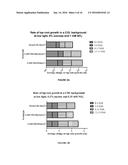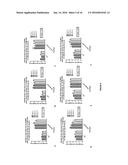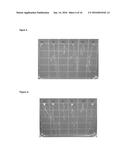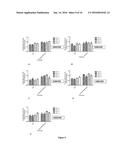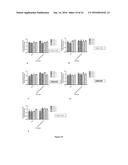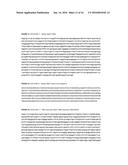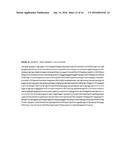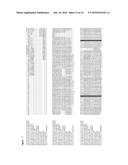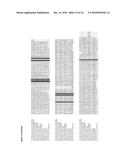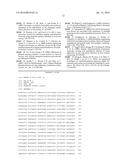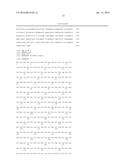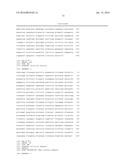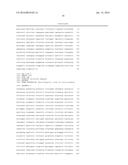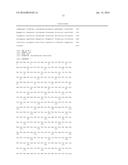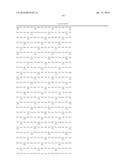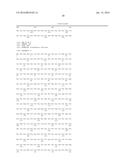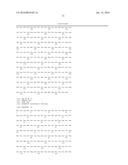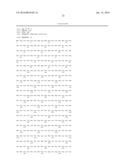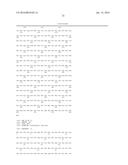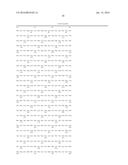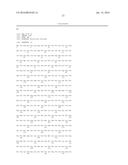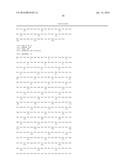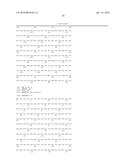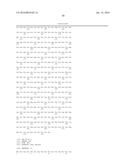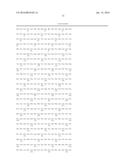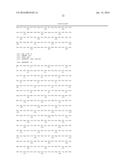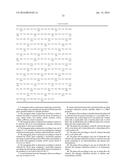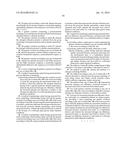Patent application title: PLANTS HAVING ENHANCED NITROGEN USE EFFICIENCY AND METHODS OF PRODUCING SAME
Inventors:
IPC8 Class: AC12N1582FI
USPC Class:
800278
Class name: Multicellular living organisms and unmodified parts thereof and related processes method of introducing a polynucleotide molecule into or rearrangement of genetic material within a plant or plant part
Publication date: 2016-01-14
Patent application number: 20160010102
Abstract:
Methods are provided for enhancing yield and nitrogen use efficiency in
plants, and to methods of increasing biomass and seed yield in plants
grown under nitrogen limiting conditions using variants of enzymes
involved in nitrogen assimilation or metabolism from non-plant organisms.Claims:
1. A transgenic plant or plant part comprising a polynucleotide encoding
a non-endogenous nitrogen utilization protein gene operably linked to a
specific promoter.
2. The transgenic plant or plant part according to claim 1, wherein the plant is selected from the group consisting of: corn, wheat, maize, rice, barley, canola, soybean, cotton, alfalfa, safflower, tomato and potato.
3. The transgenic plant or plant part according to claim 1 or 2, wherein the novel non-endogenous nitrogen utilization protein gene is from any non-plant.
4. The transgenic plant or plant part according to any one of claims 1 to 3, wherein the novel non-endogenous nitrogen utilization protein gene is alanine aminotransferase (AlaAT).
5. The transgenic plant or plant part according to claim 4, wherein the AlaAT gene comprises a nucleotide sequence encoding a protein having at least 80% amino acid identity to the amino acid sequence of barley AlaAT, mouse AlaAT or Pyrococcus AlaAt.
6. The transgenic plant or plant part according to claim 4, wherein the AlaAT gene comprises a nucleotide sequence encoding a protein having at least 80% amino acid identity to the sequence as set forth in SEQ ID NO: 2.
7. A seed obtained from the transgenic plant according to any one of claims 1 to 6.
8. A plant cell transformed with a polynucleotide encoding a nitrogen utilization protein operably linked to a PBpr1 promoter.
9. The plant cell according to claim 8, wherein the plant cell is selected from the group consisting of: a corn plant cell, a wheat plant cell, a maize plant cell, a rice plant cell, a barley plant cell, a canola plant cell, a soybean plant cell, a cotton plant cell, an alfalfa plant cell, a safflower plant cell, a tomato plant cell and a potato plant cell.
10. The plant cell according to claim 9, wherein the plant cell is a rice plant cell, a barley plant cell, a wheat plant cell or a maize plant cell.
11. The plant cell according to claim 9, wherein the plant cell is a rice plant cell.
12. The plant cell according to any one of claims 8 to 11, wherein the nitrogen utilization protein is selected from the group consisting of: an aminotransferase and alanine aminotransferase.
13. The plant cell according to any one of claims 8 to 11, wherein the nitrogen utilization protein is an aminotransferase.
14. The plant cell according to any one of claims 8 to 11, wherein the nitrogen utilization protein is alanine aminotransferase (AlaAT).
15. The plant cell according to claim 14, wherein the gene encoding the AlaAT protein comprises a nucleotide sequence substantially identical to the sequence as set forth in SEQ ID NO: 1, 3 or 4.
16. A genetic construct comprising a polynucleotide encoding a non-endogenous nitrogen utilization protein gene operably linked to a specific promoter.
17. The genetic construct according to claim 16, wherein the nitrogen utilization protein is selected from the group consisting of an aminotransferase and an alanine aminotransferase.
18. The genetic construct according to claim 17, wherein the nitrogen utilization protein is alanine aminotransferase.
19. The genetic construct according to any one of claims 16 to 18, wherein the genetic construct further comprises a transcription termination sequence, a polyadenylation region, or both.
20. The genetic construct according to any one of claims 16 to 19, wherein the specific promoter is the PBpr1 promoter, and the PBpr1 promoter comprises a nucleotide sequence substantially identical to the sequence as set forth in SEQ ID NO: 5.
21. A vector comprising the genetic construct according to any one of claims 16 to 20.
22. A method of generating a plant having increased nitrogen use efficiency comprising: transforming a plant cell with the genetic construct according to any one of claims 16 to 20 or the vector according to claim 21, and growing the transformed plant cell to produce a plant that expresses the nitrogen utilization protein from a specific promoter, thereby generating a plant having increased nitrogen use efficiency, wherein the increased nitrogen use efficiency is relative to the nitrogen use efficiency of a wild-type plant grown under identical conditions.
23. A method of generating a plant having increased biomass comprising: transforming a plant cell with the genetic construct according to any one of claims 16 to 20 or the vector according to claim 21, and growing the transformed plant cell to produce a plant that expresses the nitrogen utilization protein from the promoter, thereby generating a plant having increased biomass, wherein the increased biomass is relative to the biomass of a wild-type plant grown under identical conditions.
24. A method of generating a plant having increased seed yield comprising: transforming a plant cell with the genetic construct according to any one of claims 16 to 20 or the vector according to claim 21, and growing the transformed plant cell to produce a plant that expresses the nitrogen utilization protein from the promoter, thereby generating a plant having increased seed yield, wherein the increased seed yield is relative to the seed yield of a wild-type plant grown under identical conditions.
25. A method for producing a plant having increased nitrogen use efficiency, increased biomass, increased seed yield, earlier development time, or a combination thereof, comprising: (a) providing a plant, a plant part or a seed comprising the genetic construct according to any one of claims 16 to 20 or the vector according to claim 21, and (b) growing a plant from the plant, plant part or seed, thereby producing a plant having increased nitrogen uptake, increased biomass, increased seed yield, earlier development time, or a combination thereof, wherein the increased nitrogen uptake, increased biomass and increased seed yield is relative to the nitrogen uptake, biomass and seed yield of a wild-type plant grown under identical conditions.
26. The method of claim 25, further comprising providing a fertilizer to the plant or the habitat of the plant in step (b).
27. The method of claim 26, wherein the fertilizer is a nitrogen containing fertilizer.
28. The method according to any one of claims 22 to 27, wherein the plant is selected from the group consisting of: corn, wheat, maize, rice, barley, canola, soybean, cotton, alfalfa, safflower, sugarcane, tomato and potato.
29. The method of any one of claims 22 to 28, wherein the increased nitrogen use efficiency, increased biomass or increased seed yield is observed in the mature plant.
30. Use of the genetic construct according to any one of claims 16 to 20 or the vector according to claim 21 to increase nitrogen use efficiency, biomass or seed yield in a plant.
31. A process for increasing nitrogen use efficiency, biomass, seed yield, or a combination thereof, in a plant comprising: providing a seed comprising the genetic construct according to any one of claims 16 to 20 or the vector according to claim 21, applying a herbicide, insecticide, fertilizer, or combination thereof, to the seed, and growing a plant from the seed, wherein the plant has increased nitrogen use efficiency, increased biomass, increased seed yield, or a combination thereof, and wherein the increased nitrogen use efficiency, increased biomass or increased seed yield is relative to the nitrogen use efficiency, biomass or seed yield of a wild-type plant grown under identical conditions.
Description:
FIELD OF INVENTION
[0001] The present invention relates to plants having enhanced yield and/or nitrogen utilization efficiency (NUE), to methods for enhancing yield and NUE in plants, and to methods of increasing biomass and seed yield in plants grown under nitrogen limiting conditions.
BACKGROUND OF THE INVENTION
[0002] The productivity of plants is limited by the three primary nutrients: nitrogen, phosphorous and potassium, in most natural and agricultural ecosystems. Generally nitrogen is the most important of the three limiting nutrients and the major components in fertilizers. Since nitrogen is usually the rate-limiting element in plant growth, most field crops have a fundamental dependence on inorganic nitrogenous fertilizer. The nitrogen source in fertilizer is usually ammonium nitrate, potassium nitrate, or urea (McAllister et al., 2012).
[0003] Increased nitrogen use efficiency by plants has a number of beneficial effects, for example, increased growth and yield when compared to conventional plants grown in nitrogen poor soils, and reduced requirement for the addition of nitrogenous fertilizers to crops (Good and Beatty, 2011a). Fertilizers account for a significant percentage of the costs associated with crop production, therefore using less fertilizer would reduce the producers' costs. A reduction in fertilizer application would also lessen the environmental damage resulting from extensive nitrogenous fertilizer use. Excess fertilizer application causes increased eutrophication, acid rain, soil acidification and the greenhouse effect. These environmental disasters cause further problems such as fish kills, loss of biodiversity, increased algal blooms, loss of arable land and accelerated global climate change, affecting the world population on both social and economic scales (Good and Beatty, 2011b).
[0004] Of the commercially grown plants, monocots (which include the main cereal crops) represent a large percentage of the crops grown in the world with approximately 217 million hectares of wheat and 158 million hectares of both maize and rice planted in 2007. Approximately half of the global calorie and protein requirement is derived from wheat, rice and maize. Rice is routinely used as a model crop for genetic and physiological studies in other monocot crops including maize, wheat, sugarcane, barley, sorghum, rye and grass. Rice has a small, diploid genome that is well conserved and syntenic across monocots (McAllister et al., 2013).
[0005] In the case of NUE plant engineering, a number of different genes have been evaluated for their role in increasing the efficacy of N uptake, utilization or remobilization in the plant. One way to improve the nitrogen use efficiency (NUE) of the cereal crops would be to improve the different components of NUE. NUE can be partitioned into N uptake efficiency (NUpE) and N utilization efficiency (NUtE; Good et al., 2004). NUtE can be further reduced to N assimilation and N remobilization. Therefore, increasing the efficiency of either N uptake or N utilization, could lead to an increase in NUE of the crop. There have been a number of single genes targeted as candidates for genetic engineering to try and increase the NUE of crop plants (reviewed in Good and Beatty, 2011a and McAllister et al., 2012). Many of these candidate genes are primary N uptake and assimilation genes such as nitrate and ammonia transporters, nitrate reductase, GS and GOGAT. Gene targets that have shown an NUE phenotype in a crop plant after bioengineering overexpression include genes that are not primary N assimilation genes, but instead are involved in N metabolism further downstream than GS (glutamine synthase) and GOGAT (Glutamine oxoglutarate aminotransferase) such as alanine aminotransferase (AlaAT), or are transcriptional regulators, such as Dof1 (Good et al., 2007; Shrawat et al., 2008; Yanagisawa et al., 2000; Yanigisawa et al., 2004). While some of these genes have shown some efficacy, in most cases the over-expression of these genes, under the specific promoter used, did not result in any significant increase in NUE or components of NUE (reviewed in Good and Beatty, 2011 a and McAllister et al., 2012).
SUMMARY OF THE INVENTION
[0006] The present invention relates to plants having enhanced yield and/or nitrogen utilization efficiency (NUE) and methods of producing such plants. The present invention also relates to methods for enhancing yield and NUE in plants, and to methods of increasing biomass and seed yield in plants grown under nitrogen limiting conditions. This invention also relates to the use of AlaAT encoding polynucleotides from non-plant organisms in plants, and the use of different variants of AlaAT encoding polynucleotides from organisms such as Archaea and mammals in plants under control of a plant-expressible promoter.
[0007] It is an object of the invention to provide an improved plant having enhanced nitrogen efficiency.
[0008] According to the present invention there is provided a non-naturally occurring plant or plant part from a non-naturally occurring plant comprising, elevated levels of one or more different nitrogen utilization proteins, as described above from a plant or non-plant under control of a plant-expressible promoter.
[0009] The one or more nitrogen utilization proteins may be selected from aminotransferases, alanine aminotransferase (AlaAT) and aspartate aminotransferase. The one or more nitrogen utilization proteins may be variants of AlaAt encoding polynucleotides from non-plants, such as from Archaea and mammals.
[0010] The non-naturally occurring plant or plant part may be selected from corn, wheat, maize, rice, barley, canola, soybean, cotton, alfalfa, safflower, sugarcane, tomato and potato.
[0011] The present invention also provides a non-naturally occurring plant or plant part wherein the plant or plant part comprises a first nucleic acid encoding one or more non-naturally occurring AlaAT gene operably linked to a second nucleic acid comprising a promoter, such as, but not limited to, a tissue-specific promoter.
[0012] The present invention also pertains to a seed obtained from the non-naturally occurring plant as described above.
[0013] The present invention provides a method of generating a plant with increased nitrogen use efficiency comprising, introducing a nucleic acid encoding one or more nitrogen utilization protein, operably linked to a promoter, such as, but not limited to, a tissue-specific promoter, and producing the plant, the plant comprising elevated levels of one or more nitrogen utilization protein. The one or more nitrogen utilization protein may be selected from the group consisting of the aminotransferases. Preferably, the one or more nitrogen utilization proteins is alanine aminotransferase.
[0014] To generate monocot plants that are able to grow under suboptimal nutrient conditions, a monocot plant may be generated that uses nitrogen more efficiently. Such monocot plants are able to grow in soils that are poorer in nitrogen, as a result of being able to more efficiently use the nitrogen that is available, with no loss in yield. Additionally, such monocot plants may also demonstrate enhanced yield in soils that have normal nitrogen levels as well. Nitrogen use efficiency in plants is a result of two main subcomponents; N uptake efficiency and N utilization efficiency. A plant exhibiting a nitrogen use efficiency phenotype may have improvements in its ability to take up nitrogen from the soil, which is a desired trait in plants growing in lower nutrient-available soils. Or the NUE plant may have improvements in its ability to utilize the N that it has taken up so that the available N (whether it be low or high) is efficiently incorporated into the subcellular components (such as nucleic acids, proteins, storage etc.), translocated to the necessary tissues and remobilized at the correct developmental stage into seed. Or, another possibility is that the NUE plant has improvements in both N uptake and utilization. Any one of these possibilities would allow for an increased yield from a NUE crop grown in normal nitrogen conditions because those plants would be able to take up a non-limiting amount of nitrogen and be able to use the nitrogen to increase biomass and seed yield, either by increased number of seeds or an increase in seed weight, or both.
[0015] This present invention will allow the user to develop plants that have an environmental benefit in that they can maintain yield, while reducing the need for high levels of nutrient application. Alternatively, under high nutrient levels this invention would improve plant nutrient up-take allowing plants to extract more nutrients from their environment during times of nutrient abundance. Using the methods and compositions of the invention, plants may be improved for growth and development under environmental conditions usually unsuitable for growth of the plant. Furthermore, the methods and compositions of the invention permit the genetic engineering of a plant to alter one or more plant characteristics in only selected tissues of the plant.
[0016] The present invention provides a method for directing expression of a specific target gene or nucleotide sequence in a plant, including producing a plant from a transformed plant cell such that tissue-specific expression of a target gene or nucleotide sequence occurs within a selected tissue of the plant, wherein the transformed plant cell contains a target gene or nucleotide sequence for a novel variant to AlaAT.
[0017] The present invention further provides a method for increasing biomass of a plant growing under one or more environmentally adverse conditions comprising: transforming a plant with a novel target gene or nucleotide sequence in operative linkage with an OsANT1 or PBpr1 promoter element to produce a transformed plant, the target gene or nucleotide sequence encoding an enzyme involved in nitrogen assimilation or metabolism; and growing the transformed plant.
[0018] This invention also relates to the use of AlaAT encoding polynucleotides from non-plant organisms in plants, and the use of different variants of AlaAT encoding polynucleotides from other organisms, such as Archaea and mammals, in plants under control of a plant-expressible promoter.
[0019] Also embraced within the present invention is a method for increasing biomass of a plant growing under conditions of low nitrogen comprising: transforming a plant with a target gene or nucleotide sequence in operative linkage with an OsANT1 or PBpr1 promoter element to produce a transformed plant, the target gene or nucleotide sequence encoding an enzyme involved in nitrogen assimilation; and growing the transformed plant. Preferably, the target gene or nucleotide sequence encodes an enzyme that is a variant of AlaAT.
[0020] The present invention also pertains to a method for increasing the biomass of a plant growing under one or more environmentally adverse conditions comprising; transforming a plant with a gene or nucleotide sequence encoding AlaAT in operative linkage with a promoter element to produce a transformed plant; and growing the transformed plant.
[0021] The present invention is also directed to a method for increasing seed yield of a plant comprising: transforming the plant with a target gene or nucleotide sequence or nucleotide sequence in operative linkage with a specific promoter element, to produce a transformed plant, the target gene or nucleotide sequence or nucleotide sequence encoding an enzyme involved in nitrogen assimilation or metabolism; and growing the transformed plant. Preferably, the target gene or nucleotide sequence encodes an enzyme that is a variant of AlaAT.
[0022] Also embraced within the present invention is a method for increasing seed yield of a plant growing under conditions of high nitrogen comprising; transforming a plant with a target gene or nucleotide sequence or nucleotide sequence in operative linkage with an promoter element to produce a transformed plant, the target gene or nucleotide sequence or nucleotide sequence encoding an enzyme involved in nitrogen assimilation; and growing the transformed plant. Preferably, the target gene or nucleotide sequence encodes an enzyme that is a variant of AlaAT.
[0023] This summary of the invention does not necessarily describe all features of the invention.
BRIEF DESCRIPTION OF THE DRAWINGS
[0024] These and other features of the invention will become more apparent from the following description in which reference is made to the appended drawings wherein:
[0025] FIG. 1 outlines the components of the various constructs contemplated by the present invention. Each of these genetic constructs has a promoter operatively linked to a variant of AlaAT (including HvAlaAt, MmAlaAT1, MmAlaAT2 and PfAlaAt. These constructs are given the designation of Promoter::AlaATgene and terminated by a nos terminator. The selection marker is kanamycin (Kan) for plasmid selection and hygromycin (Hyg) for plant selection.
[0026] FIGS. 2A and 2B show the effects of specific constructs on flowering time in Arabidopsis thaliana. FIG. 2A represents the constructs introduced into the ecotype Columbia (COL background); and FIG. 2B represents the constructs introduced into the alaat1;2 double knockout line of Arabidopsis thaliana (alaat1;alaat2 Background).
[0027] FIGS. 3A and 3B show the effects of specific constructs introduced into the ecotype Columbia on average change in tap root growth (cm) over time (DAS=days after inbibition/starting) under two different conditions. FIG. 3A shows tap root growth under the condition of low light, 0% sucrose and 1 mM nitrate (NO3.sup.-); and FIG. 3B shows tap root growth under the condition of low light, 0.2% sucrose and 0.25 NO3.sup.-.
[0028] FIG. 4 shows Arabidopsis plants grown on modified 1/2 MS (Murashige and Skoog medium) supplemented with 2.5 mM alanine as the sole N source at 18 DAS. WT (COL) and AlaAT over-expressers (OE) were grown on the same plate and "blocks" are replicates that were moved accordingly. OE lines are a COL background. A: 35S::PfAlaAT; B: 35S::MmAlaAT; C: OsAnt1::HvAlaAT; D: 35S::PfAlaAT; E: 35S::MmAlaAT; F: OsAnt1::HvAlaAT.
[0029] FIG. 5 shows Arabidopsis plants grown on modified 1/2 MS supplemented with 2.5 mM alanine as the sole N source at 21 DAS. WT (COL) and AlaAT over-expressers (OE) were grown on the same plate. OE lines are a COL background over-expressing MmAlaAT1 (35S:MmAlaAT1 line 2-1-7).
[0030] FIG. 6 shows Arabidopsis plants grown on modified 1/2 MS supplemented with 2.5 mM glutamate as the sole N source. WT (COL) and AlaAT over-expressers (OE) were grown on the same plate. OE lines are a COL background over-expressing PfAlaAT (35S:PfAlaAT line 4-1).
[0031] FIG. 7 shows the change in tap root growth (cm) between 0-5 DAS of control (COL) and AlaAT over-expressers (OE) in COL background grown on modified 1/2 MS supplemented with 0.25 mM NO3.sup.- as the sole N source. A: OsAnt1::HvAlaAT; B: 35S::HvAlaAT; C: 35S::MmAlaAT2; D: 35S::MmAlaAT1; E: 35S::PfAlaAT.
[0032] FIG. 8 shows the change in tap root growth (cm) between 5-8 DAS of control (COL) and AlaAT over-expressers (OE) in COL background grown on modified 1/2 MS supplemented with 0.25 mM NO3.sup.- as the sole N source. A: OsAnt1::HvAlaAT; B: 35S::HvAlaAT; C: 35S::MmAlaAT2; D: 35S::MmAlaAT1; E: 35S::PfAlaAT.
[0033] FIG. 9 shows the change in tap root growth (cm) between 0-5 DAS of control (COL) and AlaAT over-expressers (OE) in COL background grown on modified 1/2 MS supplemented with 2 mM NO3.sup.- as the sole N source. A: OsAnt1::HvAlaAT; B: 35S::HvAlaAT; C: 35S::MmAlaAT2; D: 35S::MmAlaAT1; E: 35S::PfAlaAT.
[0034] FIG. 10 shows the change in tap root growth (cm) between 5-8 DAS of control (COL) and AlaAT over-expressers (OE) in COL background grown on modified 1/2 MS supplemented with 2 mM NO3.sup.- as the sole N source. A: OsAnt1::HvAlaAT; B: 35S::HvAlaAT; C: 35S::MmAlaAT2; D: 35S::MmAlaAT1; E: 35S::PfAlaAT.
[0035] FIG. 11 shows SEQ ID NO:1, which is the nucleotide sequence of barley (Hordeum vulgare) AlaAT used herein.
[0036] FIG. 12 shows SEQ ID NO:2, which is the amino acid sequence of barley (Hordeum vulgare) AlaAT used herein.
[0037] FIG. 13 shows SEQ ID NO:3, which is the nucleotide sequence of mouse (Mus musculus) AlaAT1 used herein.
[0038] FIG. 14 shows SEQ ID NO:4, which is the nucleotide sequence of Pyrococcus furiosus AlaAT used herein.
[0039] FIG. 15 SEQ ID NO:5, which is the nucleotide sequence of the pPBpr1 promoter element used herein.
[0040] FIG. 16 shows SEQ ID NO:6, which is the nucleotide sequence of the maize Ubiquitin 1 promoter elements, plus its first intron used herein.
[0041] FIG. 17 shows amino acid sequence comparisons of various alanine aminotransfereases (AlaAT's). Saccharomyces cerevisea AlaAT1 (SEQ ID NO:7); Saccharomyces cerevisea AlaAT2 (SEQ ID NO:8); Arabidopsis thaliana AlaAT1 (SEQ ID NO: 9); Arabidopsis thaliana AlaAT2 (SEQ ID NO: 10); Medicago truncatula AlaAT (SEQ ID NO: 11); Arabidospsis thaliana GGT1 (SEQ ID NO: 12); Arabidospsis thaliana GGT2 (SEQ ID NO: 13); Pyrococcus furiosus AlaAT (SEQ ID NO: 14); Mus musculus AlaAT1 (SEQ ID NO: 15); Mus musculus AlaAT2 (SEQ ID NO: 16); Homo sapiens AlaAT1 (SEQ ID NO: 17); Homo sapiens AlaAT2 (SEQ ID NO: 18).
[0042] FIG. 18 shows average biomass and average seed weight from T1 transgenic Oryza sativa plant lines (11 lines with each 6 plants selected by biomass and seed weight). Hatched bars: average biomass; solid bars: average seed weight.
DETAILED DESCRIPTION
[0043] The present invention relates to monocot plants having enhanced yield and/or nitrogen utilization efficiency (NUE), to methods of producing such plants, to methods for enhancing yield and NUE in monocot plants, and to methods of increasing biomass and seed yield in monocot plants grown under nitrogen limiting conditions. This invention also relates to variants of AlaAT and their operative linkage with different promoters, for example, without limitation, the cauliflower mosaic virus promoter CaMV 35S and tissue specific promoters (such as OsANT1 and PBpr1; Shrawat et al., 2008; Lock, 2011). The present invention also relates to the use of AlaAT encoding polynucleotides from non-plant organisms in plants, and the use of different variants of AlaAT encoding polynucleotides from organisms such as Archaea and mammals in plants under control of a plant-expressible promoter.
[0044] The following description is of a preferred embodiment.
[0045] The headings provided are not meant to be limiting of the various embodiments of the invention. Terms such as "comprises", "comprising", "comprise", "includes", "including" and "include" are not meant to be limiting. In addition, the use of the singular includes the plural, and "or" means "and/or" unless otherwise stated. Unless otherwise defined herein, all technical and scientific terms used herein have the same meaning as commonly understood by one of ordinary skill in the art.
[0046] The language "tissue-specific expression of a target nucleotide sequence" is known in the art and includes the expression of a target nucleotide sequences in only selected tissues; although the target nucleotide sequence may be present in multiple tissues, it is expressed in only a subset of those tissues. Such selective expression may be due to the influence of one or more regulatory genetic elements, for example but not limited to promoter elements, repressor elements, enhancer elements, or other regulatory factors that may interact with DNA, RNA.
[0047] The language "target gene" or "target nucleotide sequence" is art-recognized, and includes any nucleotide sequence which is desirably expressed in one or more selected plant tissues. Examples of target genes or nucleotide sequences which may advantageously be utilized in conjunction with the methods of the invention include genes or nucleotide sequences involved in nitrogen assimilation and/or utilization, genes or nucleotide sequences involved in stress resistance or disease and pest resistance, and genes or nucleotide sequences involved in nutrient uptake and utilization. Such genes or nucleotide sequences are well known to one of skill in the art.
[0048] The language "plant" is art-recognized, and includes any monocotyledenous or dicotyledenous plant. Examples of plants for use in the invention include but are not limited to canola, barley, maize, rice, tobacco, soybean, cotton, alfalfa, tomato, wheat, potato, Arabidopsis thaliana and certain tree genera, including conifers and Populus species.
[0049] The language "non-plant" includes any other organisms that are not plants, such as, but not limited to, microorganisms (for example, without limitation, bacteria, yeast, fungi, algae, Archaea, virus), mammals and non-mammals (for example, without limitation, arthropods, birds, reptiles, amphibians and fish).
[0050] The language "operative linkage" is art-recognized, and includes the placement of a target nucleotide sequence relative to a nucleic acid regulatory sequence such that the expression of the target nucleotide sequence is controlled by the regulatory sequence. This regulatory sequence can have a positive effect (increase) on the expression of the target gene or nucleotide sequence (e.g., the regulatory sequence is a promoter or an enhancer element), or the regulatory sequence can reduce the expression of the target gene or nucleotide sequence (e.g., the regulatory sequence is a repressor element). The regulatory sequence may be physically located 5' or 3' of the target gene or nucleotide sequence, may be within the coding sequence of the target gene or nucleotide sequence, or may be contained on an intron within the target gene or nucleotide sequence.
[0051] The language "nulls" is art-recognized and includes a plant that has undergone tissue culturing but does not carry a transgene or selectable marker.
[0052] Production of plants which express one or more target genes or nucleotide sequences under a plant-expressible promoter are described herein. The invention further provides seeds containing one or more target genes or nucleotide sequences under the control of a plant-expressible promoter, such as a tissue-specific promoter element that specifically directs the tissue-specific expression of the gene or nucleotide sequence. By the methods of the invention, it is possible to produce plants having one or more desired traits or properties in selected tissues; e.g., to alter specifically the genetic and/or physiological properties of the fruit or the roots of the plant. The invention further provides methods of producing plants having root and leaf-specific expression of one or more desired nucleotide sequences, using the OsANT1 and PBpr1 promoter elements (Shrawat et al., 2008; Lock, 2011).
[0053] The methods of the invention for the production of plants involve the operative linkage of one or target genes or nucleotide sequences to a genetic regulatory element, such as, but not limited to, a promoter. As is known in the art, promoters are nucleic acid sequences that allow for regulation of transcription of a gene or nucleotide sequence. Promoters can allow for constitutive expression, such as the well known cauliflower mosaic virus promoter CaMV 35S, inducible expression, such as the stress inducible promoter rd29A (Pino et al., 2007), tissue-specific expression, such as the root-specific OsANT1 promoter (Good et al., US 2009/0288224), and developmentally specific expression, such as the senescence induced IPT promoters (Ma 2008). Promoters can also be weak or strong, suggesting that whenever or wherever they are induced, they will allow for expression of the attached gene or nucleotide sequence at varying levels.
[0054] The methods of the invention for the production of plants having tissue-specific expression of one or more target genes or nucleotide sequences are accomplished through the use of a genetic regulatory element which directs the tissue-specific expression of the target gene(s). This regulatory element may be either negative or positive in activity: a plant tissue-specific promoter or enhancer element permits the expression of the target gene or nucleotide sequence(s) in one or more specific tissues, whereas a plant tissue-specific repressor suppresses the expression of the target genes or nucleotide sequences in one or more specific tissues, while expression in the other tissue(s) continues unabated. For the purposes of the present invention, it will be understood that promoter sequences constitute the preferred genetic regulatory elements of the invention.
[0055] It will be understood by one skilled in the art that modifications may be made to the promoters used in the methods and constructs of the invention to improve or modulate the activity of the promoter. Multiple copies of a selected promoter may be operatively linked to a single target gene or nucleotide sequence to thereby alter the expression level of the linked gene or nucleotide sequence, or a selected promoter may be operatively linked to one or more target genes or nucleotide sequences such that the expression of each target gene or nucleotide sequence is coordinately regulated. A promoter may be of any size appropriate to permit the tissue-specific functioning of the promoter. A promoter may be modified (e.g., by mutagenesis, deletion, insertion, or truncation) to alter the degree to which the operatively linked gene or nucleotide sequence is expressed in the selected tissue, or to alter the specificity of tissue expression directed by the promoter. Further, the placement of the promoter relative to the operatively linked target gene or nucleotide sequence may be modulated (e.g., moved further away or closer together) to attain a desired level of promoter-directed expression.
[0056] A target gene or nucleotide sequence of the invention may be any gene or nucleotide sequence which is desirably expressed in a plant, including the expression in a tissue-specific manner in a plant. General classes of target genes or nucleotide sequences that may be employed in the methods and constructs of the invention include one or more genes or nucleotide sequences encoding plant structural proteins, genes or nucleotide sequences encoding proteins involved in the transport and/or uptake of nutrients, genes or nucleotide sequences encoding enzymes and proteins involved in nutrient utilization, genes or nucleotide sequences encoding proteins involved in stimulation or continuation of plant growth. Further, the target gene or nucleotide sequence may be a nucleotide sequence which, when transcribed, is antisense to a native sequence, the transcription and translation of which is desired to be suppressed.
[0057] For example, which is not to be considered limiting in any manner, the genes or nucleotide sequences of interest are those encoding enzymes in the assimilation and/or metabolism of nitrogen. The genes or nucleotide sequences of interest may include genes or nucleotide sequences which encode proteins involved in assimilating ammonia into amino acids or use the formed amino acids in biosynthetic reactions, that is, "nitrogen utilization proteins". Example of nitrogen utilization proteins include, but are not limited to, nitrate ammonium and amino acid transporters, glutamine synthetase (GS), asparagine synthetase (AS), glutamate synthase (also known as glutamate 2:oxogluturate amino transferase and GOGAT), asparaginase (ANS), glutamate dehydrogenase (GDH), aspartate aminotransferase (AspAT) and alanine aminotransferase (AlaAT) and those genes or nucleotide sequences which may be involved in Nutrient Use Efficiency (NUE) as described by Beatty et al. (2009), and in U.S. Pat. No. 7,589,257 (which is incorporated herein by reference).
[0058] The target gene or nucleotide sequence may be a gene or nucleotide sequence naturally expressed in a selected plant (endogenous), or it may be not naturally expressed in the selected plant (non-endogenous). The gene or nucleotide sequence may originate from a plant or from a non-plant, including, without limitation, viral, bacterial, Archaea or animal sources. Preferably, the gene or nucleotide sequence is heterologous to the promoter to which it is linked, in that it is not linked to an unmodified, inducible promoter to which the gene or nucleotide sequence is naturally linked Thus, as used herein, the term "heterologous" with respect to a nucleic acid or DNA refers to a nucleic acid or DNA which is operably linked to a nucleic acid to which it is not naturally linked in nature. For example, a promoter is said to be heterologous with respect to a coding region, when that promoter is not naturally linked to that coding region.
[0059] As used herein, the term "endogenous" with respect to a nucleic acid molecule or a polypeptide in an organism refers to a nucleic acid molecule or a polypeptide having a nucleotide sequence or respectively an amino acid sequence, which is naturally occurring within cells of that organism. Nucleic acid molecules or polypeptides do not become endogenous to a particular organism because that organism or cells of that organism have been modified using, for example, recombinant DNA techniques to artificially contain such nucleic acid molecule or polypeptide. Therefore, as used herein, a "non-endogenous" nucleic acid molecule or polypeptide is a nucleic acid molecule or polypeptide that is not naturally occurring with cells of an organism, and may have been artificially introduced.
[0060] It is therefore contemplated herein that the target gene or nucleotide sequence be a non-plant, non-endogenous AlaAT for expression in a plant, such as SEQ ID NOs: 1, 3 or 4 and Mus musculus AlaAT2, which is known in the art (see for example McAllister et.al, 2013; which is incorporated herein by reference). The target gene or nucleotide sequence can be any non-plant nucleotide sequence having an nucleic acid sequence similarity of approximately 70% to the nucleic acid sequence of barley (Hordeum vulgare) AlaAT (SEQ ID NO:1), mouse (Mus musculus) AlaAT (SEQ IDNO:3), Mus musculus AlaAT2, (McAllister et.al, 2013), or Pyrococcus furiosus AlaAT (SEQ ID NO:4), or any amount between 70% and 100% amino acid sequence, for example, but not limited, to 70, 71, 72, 73, 74, 75, 76, 77, 78, 79, 80, 81, 82, 83, 84, 85, 86, 87, 88, 89, 90, 91, 92, 93, 94, 95, 96, 97, 98 or 99% nucleic acid sequence similarity to the nucleic acid sequence of barley (Hordeum vulgare) AlaAT, mouse (Mus musculus) AlaAT, Mus musculus AlaAT2, (McAllister et.al, 2013), or Pyrococcus furiosus AlaAT, or any amount therebetween.
[0061] Sequence identity or sequence similarity may be determined using a nucleotide sequence comparison program, such as that provided within DNASIS (for example, using, but not limited to, the following parameters: GAP penalty 5, #of top diagonals 5, fixed GAP penalty 10, k-tuple 2, floating gap 10, and window size 5). However, other methods of alignment of sequences for comparison are well-known in the art for example the algorithms of Smith & Waterman (1981, Adv. Appl. Math. 2:482), Needleman & Wunsch (J. Mol. Biol. 48:443, 1970), Pearson & Lipman (1988, Proc. Nat'l. Acad. Sci. USA 85:2444), and by computerized implementations of these algorithms (e.g. GAP, BESTFIT, FASTA, and BLAST), or by manual alignment and visual inspection.
[0062] Also included are nucleotide sequences that hybridize under stringent hybridization conditions to SEQ ID NO:1; SEQ ID NO:3; SEQ ID NO:4, or Mus musculus AlaAT2, (McAllister et.al, 2013). The present invention also includes a nucleotide sequence that hybridizes under stringent hybridization conditions to a compliment of SEQ ID NO:1; SEQ ID NO:3; SEQ ID NO:4, or Mus musculus AlaAT2, (McAllister et.al, 2013). These nucleotide sequences that hybridize to SEQ ID 1, 3, 4, or Mus musculus AlaAT2, (McAllister et.al, 2013), a complement of SEQ ID 1, 3, 4, or Mus musculus AlaAT2, (McAllister et.al, 2013), encode a protein that exhibits AlaAT activity.
[0063] Hybridization under stringent hybridization conditions is known in the art (see for example Current Protocols in Molecular Biology, Ausubel et al., eds. 1995 and supplements; Maniatis et al., in Molecular Cloning (A Laboratory Manual), Cold Spring Harbor Laboratory, 1982; Sambrook and Russell, in Molecular Cloning: A Laboratory Manual, 3rd edition 2001; each of which is incorporated herein by reference). An example of one such stringent hybridization conditions may be about 16-20 hours hybridization in 4×SSC at 65° C., followed by washing in 0.1×SSC at 65° C. for an hour, or 2 washes in 0.1×SSC at 65° C. each for 20 or 30 minutes. Alternatively, an exemplary stringent hybridization condition could be overnight (16-20 hours) in 50% formamide, 4×SSC at 42° C., followed by washing in 0.1×SSC at 65° C. for an hour, or 2 washes in 0.1×SSC at 65° C. each for 20 or 30 minutes, or overnight (16-20 hours), or hybridization in Church aqueous phosphate buffer (7% SDS; 0.5M NaPO4 buffer pH 7.2; 10 mM EDTA) at 65° C., with 2 washes either at 50° C. in 0.1×SSC, 0.1% SDS for 20 or 30 minutes each, or 2 washes at 65° C. in 2×SSC, 0.1% SDS for 20 or 30 minutes each.
[0064] In addition, the target gene or nucleotide sequence can be any non-plant nucleotide sequence having an amino acid sequence similarlity of approximately 80% to the amino acid sequence of barley (Hordeum vulgare) AlaAT, mouse (Mus musculus) AlaAT or Pyrococcus furiosus AlaAT, or any amount between 80% and 100% amino acid sequence, for example, but not limited, to 81, 82, 83, 84, 85, 86, 87, 88, 89, 90, 91, 92, 93, 94, 95, 96, 97, 98 or 99% amino acid sequence similarity to the amino acid sequence of barley (Hordeum vulgare) AlaAT, mouse (Mus musculus) AlaAT or Pyrococcus furiosus AlaAT, or any amount therebetween (see FIG. 17). For example, the following sequences may be used:
TABLE-US-00001 mRNA NCBI Protein NCBI Species Gene Reference Reference H. sapiens GPT NM_005309.2 NP_005300.1 M. mulatta GPT XM_001093616.2 XP_001093616.1 C. lupus GPT XM_847258.2 XP_852351.2 B. taurus GPT NM_001083740.1 NP_001077209.1 M. musculus Gpt NM_182805.2 NP_877957.1 R. norvegicus Gpt NM_031039.1 NP_112301.1 D. rerio gpt21 NM_001142774.1 NP_001136246.1 D. rerio LOC100148522 XM_001919861.2 XP_001919896.1 S. cerevisiae ALT1 NM_001181976.1 NP_013190.1 K. lactis KLLA0F19162g XM_455940.1 XP_455940.1 S. pombe SPBC582.08 NM_001021084.1 NP_595176.1 318829 MGG_06503 XM_369988.2 XP_369988.2 N. crassa NCU03973 XM_952519.2 XP_957612.1 A. thaliana ALAAT2 NM_105892.4 NP_565040.2 A. thaliana AlaAT1 NM_101591.5 NP_173173.3 O. sativa Os10g0390500 NM_001071039.1 NP_001064504.1 Genbank NCBI Species Protein Accession No. Reference Thermococcus sp. Alanine aminotransferase AEK72704.1 Thermococcus sp. Aspartate aminotransferase EEB72915.1 YP_002581272.1 Thermococcus Aspartate aminotransferase ADT83250.1 YP_004070473.1 barophilus Thermococcus Alanine aminotransferase ZP_11216073.1 zilligii Thermococcus sp. aminotransferase 2 AFL94660.1 YP_006424454.1 Thermococcus Alanine aminotransferase ACS33579.1 YP_002959443.1 gammatolerans Thermococcus Alanine aminotransferase ACJ15716.1 YP_002306613.1 onnurineus Thermococcus Alanine aminotransferase ACS90484.1 YP_002994833.1 sibiricus Thermococcus alanine aminotransferase BAD85283.1 YP_183507.1 kodakarensis Thermococcus Alanine aminotransferase AAK98527.1 ZP_09730551.1 litoralis Pyrococcus Alanine aminotransferase AEH24862.1 YP_004624134.1 yayanosii Pyrococcus sp. alanine aminotransferase AEC52815.1 YP_004424819.1 Pyrococcus sp. alanine aminotransferase AFK22834.1 YP_006354909.1 Pyrococcus alanine aminotransferase NP_143210.1 horikoshii Pyrococcus abyssi alanine aminotransferase NP_126507.1 Pyrococcus furiosus Chains A, B, C and D alanine 1XI9_A aminotransferase
[0065] The target gene or nucleotide sequence may be, but not necessarily, modified as required. For example, the gene or nucleotide sequence may be modified to be transcribable and translatable in a plant system; for example, the gene or nucleotide sequence can be modified such that it contains all of the necessary poly-adenylation sequences, start sites and termination sites which allow the coding sequence to be transcribed into messenger ribonucleic acid (mRNA) and the mRNA to be translated into a functional protein in the selected plant system. Further, the target gene or nucleotide sequence may be modified such that its codon usage is more similar to that of native genes or nucleotide sequences or nucleotide sequences of the selected plant. Such target gene or nucleotide sequence modifications and the methods by which they may be made are well known in the art.
[0066] The methods and genetic constructs disclosed herein may be used to produce a plant or a plant part of any species capable of utilizing the promoter such that the transgenic plant, or non-natural plant, has tissue-specific expression of one or more desired genes or nucleotide sequences. Both monocotyledenous and dicotyledenous plants are amenable to such alteration. The invention is intended to be particularly applicable to, for example, crop plants (especially those of the genus Oryza), ornamental plants, and trees (particularly conifers and the genus Populus). Particularly suitable plants for the practice of the present invention include, but are not limited to, canola, barley, sugar cane, corn, canola, tobacco, soybean, cotton, alfalfa, tomato, wheat, potato, aspen, cottonwood, Arabidopsis thaliana, conifers and poplar, or parts of any of these plants, for example, roots, root tips, leaves, stems, flowers, apical buds, meristematic tissues, and the like.
[0067] The transgenic plants (non-natural plants), plant parts, and seeds produced according to the present invention may be further useful in breeding programs for the production of plant species having more than one desired trait. For example two transgenic plants of the invention each having expression of a desired transgene in differing plant tissues may be crossed to result in progeny transgenic plants having tissue-specific expression of both transgenes; or two transgenic plants of the invention each having expression of a different desired transgene in the same plant tissue may be crossed to result in progeny transgenic plants having tissue-specific expression of both transgenes. In this fashion it is possible to produce transgenic plants having a combination of desirable traits in selected tissue(s) of the plant.
[0068] Furthermore, it will be understood by one skilled in the art that different species of plants may be more or less amenable to genetic manipulation in general, and that, therefore, it may be advantageous to first transform a related species of the desired plant by the methods and with the constructs of the invention and to subsequently introduce the tissue-specific expression of the target gene or nucleotide sequence into the desired plant species by cross-breeding techniques. Such techniques and appropriately related plant species are well known to one skilled in the art.
[0069] Plant cells or protoplasts that have been transformed with the gene constructs of the present invention can be regenerated into differentiated plants using standard nutrient media supplemented with shoot-inducing or root-inducing hormone, using methods known to those skilled in the art (see, for example, Shahin, E. A. U.S. Pat. No. 4,634,674 and references therein, incorporated herein by reference in their entirety). Seeds may additionally be harvested from such transgenic plants using methods well known in the art and further used to re-grow the transgenic plants and hybrids of the invention.
Uses of the Invention
[0070] The methods and constructs of the invention allow the production of plants and seeds having expression of one or more desired genes or nucleotide sequences in one or more selected tissues of the plant. Thus, the methods and constructs of the invention permit the production of plants having one or more desired traits limited to selected plant tissues, thereby enabling the targeting of a trait to the tissue to which it is best suited, or avoiding the expression of a desirable gene or nucleotide sequence in a tissue where its effects are unwanted. There are a wide variety of specific applications of the invention, including, but not limited to, the production of plants having increased yield, stress tolerance, having improved nutrient uptake and/or utilization, having improved nutrient content and/or yields of desired compounds. Specific applications of the invention are further described below.
[0071] One application of the invention is in the production of plants better able to thrive on nutrient-poor soils. It is well known in the art that certain plant species, particularly crop plants, deplete the soil of nutrients necessary to sustain growth, such as nitrogen, phosphate, and potassium. In order to replenish the lacking nutrients, it is necessary either to fertilize the soil (an expensive and environmentally damaging procedure) or to cultivate plants known to deposit the depleted nutrient into the soil (e.g., clover or soybean in the case of nitrogen depletion), which may be crops that are less profitable or nutritive and therefore less desirable to grow. Frequent fertilizing to maintain optimal nutrients in the soil is costly in terms of agriculture outputs such as labour and fuel therefore crop plants are usually in a state of either nutrient abundance or depletion. Another application of the invention is in the production of plants better able to capture and utilize nitrogen when it is present in either an adequate or abundant supply in the soil before nitrogen loss due to leaching, volatilization or microbial degradation occurs. The methods of the invention permit the targeted expression of genes or nucleotide sequences involved in nutrient uptake (e.g., transport molecules) to those tissues in which the uptake occurs (e.g., the root or root hairs) to thereby improve the ability of the plant to absorb the nutrient from the environment. The invention may also be used to produce plants which express heterologous nutrient utilization nucleotide sequences, or optimized (for example, optimized for plant expression) native nutrient utilization nucleotide sequences, in selected tissues (e.g., the root or leaves) that permit more efficient use of the nutrient, such that less of the nutrient is required for the normal growth and functioning of the plant. Further, it is possible, using the methods of the invention, to express genes or nucleotide sequences involved in the use and uptake of nutrients not normally used by the plant in those plant tissues which are directly exposed to the different nutrient (e.g., root and leaf). In this fashion, plants which are able to grow and thrive on different nutrient sources (e.g., different nitrogen sources) may be produced.
[0072] Development of Novel Cereal Crops:
[0073] As described below, Oryza sativa (rice) plants may be transformed with novel gene contracts such that the plants ectopically express a nucleotide sequence encoding an enzyme involved in nitrogen assimilation or metabolism, for example, but not limited to, alanine dehydrogenase, glutamine synthetase, asparagine synthetase, glutamate synthase, asparaginase, glutamate dehydrogenase, aspartate aminotransferase, alanine aminotransferase, and those nucleotide sequences which may be involved in Nutrient Use Efficiency described by Beatty et al. (2009), and U.S. Pat. No. 7,589,257. The present invention contemplates transformation of Oryza sativa with a novel gene construct, as described above, operatively linked to a tissue-specific promoter. The transformed plant is grown under laboratory conditions to determine the beneficial effects of tissue-specific expression on plant growth and yield under controlled growth conditions.
[0074] As indicated in Example 4 below, transgenic plants expressing a gene or nucleotide sequence encoding an enzyme involved in nitrogen assimilation or metabolism under the control of a tissue-specific promoter (pPBpr1) exhibited higher biomass and seed weight than those plants expressing a gene or nucleotide sequence expressed under a constitutive promoter (maize ubiquitin 1 promoter, ubi-1) in the presence of an adequate supply of nitrogen.
[0075] Transgenic Oryza plants ectopically expressing a gene or nucleotide sequence encoding an enzyme involved in nitrogen assimilation or metabolism under the control of a tissue-specific promoter (pPBpr1) are also capable of optimising the utilization of available nitrogen under a range of environmental conditions thereby resulting in an increase in plant biomass, seed weight or a combination thereof.
[0076] Therefore, the present invention provides a method for increasing seed yield of a plant comprising; transforming the plant with a target gene or nucleotide sequence in operative linkage with a promoter element, to produce a transformed plant, the target gene or nucleotide sequence encoding an enzyme involved in nitrogen assimilation or metabolism; and growing the transformed plant.
[0077] The above description is not intended to limit the claimed invention in any manner, furthermore, the discussed combination of features might not be absolutely necessary for the inventive solution.
[0078] The present invention will be further illustrated in the following examples. In order to assess whether enzyme isoforms of AlaAT have different kinetics and if different isoforms favor an NUE phenotype, AlaAT from mouse and Pyrococcus were tested.
EXAMPLES
Materials and Methods
[0079] Expression Vector Construction and Arabidopsis thaliana Transformation
[0080] The alanine aminotransferase enzymes assayed were chosen based on differences in their amino acid sequence as described by McAllister et al. 2012 (see also FIG. 17) and the availability of a cloned gene. Hordeum vulgare AlaAT (GenBank accession no. Z26322) (HvAlaAT) cDNA, described by Muench and Good (1994), as well as the pCAMBIA 1300 vector containing HvAlaAT driven by an OsANT1 promoter (OsANT1:HvAlaAT) and OsANT1 promoter driving β-glucuronidase (Shrawat et al., 2008) were obtained from Ashok Shrawat, University of Alberta. Mouse (Mus musculus) AlaAT1 (MmAlaAT1) (GenBank accession no. NP--877957) and mouse (Mus musculus) AlaAT2 (MmAlaAT2) (GenBank accession no. NP--776291) were both obtained from Rong ze Yang, University of Maryland (Yang et al., 2009). Pyrococcus furiosus AlaAT (PfAlaAT) (GenBank accession no. NP--579226) was amplified from ATCC gDNA (DSM 3638). Restriction enzyme cut sites were incorporated at the 5 and 3 prime ends of each cDNA using primers specific to each AlaAT as outlined in detail in McAllister et al., 2012. HvAlaAT construction of the AlaAT plasmids was done as outlined in McAllister et al., 2012. The nucleotide sequences of barley (Hordeum vulgare) AlaAT, mouse (Mus musculus) AlaAT1, and Pyrococcus furiosus AlaAT used herein are provided as FIGS. 11, 13 and 14, respectively (SEQ ID NOs: 1, 3 and 4, respectively). Mouse (Mus musculus) AlaAT2 is as previously described. The final AlaAT constructs for transformation into Arabidopsis thaliana, the initial AlaAT source, the promoter used to drive AlaAT expression in vivo, as well as the binary vectors utilized for transformation are summarized in Table 1.
TABLE-US-00002 TABLE 1 List of promoters, genes and sequences used to build the specific expression vectors for transformation into Arabidopsis thaliana. Vector Accession Termi- Vector Name Promoter Gene # nator Backbone Arabidopsis 2XCaMV35S HvAlaAT Z26322 nos binary vector pMDC32 Arabidopsis 2XCaMV35S Mm1AlaAT NP_877957 nos binary vector pMDC32 Arabidopsis 2XCaMV35S Mm2AlaAT NP_776291 nos binary vector pMDC32 Arabidopsis 2XCaMV35S PfAlaAT NP_579226 nos binary vector pMDC32 Arabidopsis OsAnt1 HvAlaAT Z26322 nos binary vector pMDC32
[0081] Binary vectors were transformed into Agrobacterium tumefaciens strain GU3101 and selected using kanamycin. Agrobacterium cultures (0D600 0.3-0.7) were then used to transform Arabidopsis thaliana plants, both COL (ecotype Columbia background) and alaat1;2 knockout backgrounds, using floral dip (alaat1;2 knockout background is explained in detail in Miyashita, 2008). Transformed plants were selected by sowing seeds on hygromycin (Hyg) and using a protocol modified from Harrison et al., (2006), with plants left covered at 4° C. for 4 days and at room temperature for 3 days; PCR was carried out on all primary transgenics with primers specific to the AlaAT insert: for HvAlaAT, 5'-GAGGTTCTTGCCCTTTGTGA-3' and 5'-TTCAGCTCGTTGCAAGTAA-3'; for MmAlaAT1,5'-CCAGAGGATGCCAAGAGAAG-3' and 5'-GCTCCGTGAGTTTAGCCTTG-3'; for MmAlaAT2,5'-GCAGGCTTGTGGTGGAAA-3' and 5'-GCACTTTCTTAAAGGAGTGGAATC-3'; for PfAlaAT, 5'-GCGCTCTACGACAAAAAGACACTTGA-3' and 5'-CGTTAGTCCTGCTATAGCTGCGAATT-3'. T3 seed was sown on Hyg media to select for homozygous lines; PCR was used to verify the presences of the specific AlaAT insertions. Three independent Arabidopsis insertion lines for each AlaAT construct, in both COL and alaat1;2 knockout backgrounds, were selected for and used for future analyses.
[0082] Plate Assays
[0083] Sterilized seeds were stratified in 0.15% (w/v) agar for approximately 48 hrs; sterilized seeds were sown onto square 100×100×15 mm petri plates containing modified 1/2 MS media (0.5% (w/v) sucrose and 0.8% (w/v) agar) with 0 mM KNO3.sup.-, 2 mM KNO3.sup.-, 0.25 mM KNO3.sup.-, 2.5 mM alanine or 2.5 mM glutamate as the sole nitrogen source. Seeds from both control lines, COL and alaat1;2, as well as three independent insertion lines each of OsANT1:HvAlaAT, CaMV35S:PfAlaAT, CaMV35S:HvAlaAT, CaMV35S:MmAlaAT1 and CaMV35S:MmAlaAT2, in both a COL and an alaat1;2 knockout background, were used for analysis on 0 mM, 0.25 mM and 2 mM KNO3.sup.- plates.
[0084] Transgenic plants containing OsANT1:HvAlaAT, CaMV35S:PfAlaAT and CaMV35S:MmAlaAT1, in both COL and alaat1;2 knockout backgrounds, were used for analysis on 2.5 mM glutamate and alanine. Plants were sown horizontally across square petri plates approximately 2 cm from the top of each plate; 6 plants were sown per plate. Control plants and transgenics were sown on the same plates in an alternating fashion. Three independent insertion lines for each AlaAT were assayed in quadruplicate along with control plants. Plants were grown vertically at 21° C., 60% humidity and a lighting cycle of 16 light/8 dark. Chambers were blocked for variations in lighting conditions, resulting in four blocks, with final lighting blocks containing a maximum difference of 20% across a single block with an average light intensity of 170 μE m-2 sec-1. Plates were moved within lighting blocks daily and monitored for changes in growth and development. Changes in vertical tap root length were measure (cm) between 0-5 after sowing (DAS), 5-8 DAS and 8-12 DAS for plants grown on 2 mM and 0.25 mM KNO3.sup.-. The vertical growth of tap roots of plants grown on 2.5 mM glutamate and alanine was measured (cm) between 0-5, 5-8, 8-12, 12-15, 18 and 21 DAS for changes in root length. Changes in tap root lengths over these time periods were then used to analyze the rate of tap root growth between transgenics and controls. At 18 DAS or 21 DAS (earlier if plants were senescing or had grown too large for plates) tap root lengths were measured (cm) on all 1/2 MS plates (top of hypocotyl to root tip).
[0085] 1/2 MS plates were also prepared varying nitrogen and carbon amounts. Modified 1/2 MS (0.8% (w/v) agar) containing 1 mM KNO3.sup.- and 0% (w/v) sucrose was used to grow transgenic plants containing OsANT1:HvAlaAT, CaMV35S:PfAlaAT and CaMV35S:MmAlaAT1, in both COL and alaat1;2 knockout backgrounds, as well as control lines, in two different lighting conditions: ˜170 μE m-2 sec-1 (high) and ˜100 μE m-2 sec-1 (low) (see FIG. 3A). Modified 1/2 MS containing 0.25 mM KNO3.sup.- and 0.2% (w/v) sucrose was also used to grow all of the above lines in a low light condition (˜100 μE m-2 sec-1) (see FIG. 3B). Changes in vertical tap root length were measured (cm) between 0-5 DAS, 5-8 DAS, 8-12 DAS and 12-15 DAS for all plates (top of hypocotyl to root tip) to assess the rate of tap root growth between transgenic and control lines. Plating, blocking and data collection, as well as chamber conditions for the growth of plants on these plates, was as outlined previously.
[0086] Phenotypic similarity between individual plant lines expressing the same AlaAT construct in all plating conditions was assessed via one-way ANOVA (α=0.05, P value<0.05). Final tap root lengths of control plants and transgenic lines were compared using two-way ANOVA (P value<0.05), analyzing the genotype of plants and the lighting block plants were grown in.
[0087] Analysis of AlaAT Primary Structure
[0088] The enzymes with AlaAT activity that were obtained for expression studies and kinetic analysis and the amino acid sequences were compared using ClustalW software (full primary sequence comparison is provided in McAllister et al. 2012 (see FIG. 17).
[0089] Construction of Binary Vectors and Agrobacterium Mediated Transformation
[0090] The sequences of the genes using in the cloning are described in FIGS. 11 and 13-16 (SEQ ID NOs: 1 and 3-7, respectively) and the components for the gene constructs are provided in FIG. 1. PBpr1 promoter (SEQ ID NO: 5) was selected for tissue-specific expression in rice (Oryza sativa c.v. Nipponbare (NB)) and designed to be cloned using GeneArt (Invitrogen, Life Technologies, Carlsbad, Calif., USA). The constitutive promoter, maize Ubiquitin 1 promoter (SEQ ID NO: 6) was selected for expression in rice (Oryza sativa c.v. Nipponbare (NB)). The HvAlaAT cDNA (SEQ ID NO: 1) was introduced into pCAMBIA1300.
[0091] The constructs were transformed separately into Agrobacterium tumefaciens strain EHA105 by the freeze thaw method (Weigel and Glazebrook, 2002). The transformation of Arabidopsis thaliana is as described above.
[0092] Rice callus (Oryza sativa c.v. Nipponbare (NB)) was transformed with constructs, using an Agrobacterium transformation system developed in our laboratory (Shrawat and Good, 2011). The final AlaAT constructs for transformation into Oryza sativa c.v. Nipponbare (NB), the initial AlaAT source, the promoter used to drive AlaAT expression in vivo, as well as the binary vectors utilized for transformation are summarized in Table 2.
TABLE-US-00003 TABLE 2 List of promoters, genes and sequences used to build the specific expression vectors for transformation into Oryza sativa. Vector Accession Termi- Vector Name Promoter Gene # nator Backbone pGPMn PBpr1 Mm1AlaAT NP_877957 nos pGPro2 pGPPn PBpr1 PfAlaAT NP_579226 nos pGPro2 pGUMn UBi1 Mm1AlaAT NP_877957 nos pGPro2 pGUPn UBi2 PfAlaAT NP_579226 nos pGPro2
EXAMPLE 1
[0093] Novel AlaAT gene constructs (CaMV35S::MmAlaAT1;CaMV35S::PfAlaAT; and OsAnt1::HvAlaAT1) were introduced into either the alaat1;2 double knock out (DNK) (FIG. 2B) or the normal genetic background (COL background) (FIG. 2A).
[0094] The novel AlaAT gene constructs reduced the time to flowering in the transgenic Arabidopsis thaliana.
[0095] Furthermore, the introduction of a novel AlaAT gene into either the normal genetic background or the DNK background, under two different conditions (as described above) increases the rate of root growth of the transgenic plant, and this rate changes as the plants get older (see FIGS. 3A and 3B). FIG. 3A illustrates the rate of tap root growth (cm) over 0-5, 5-8, 8-12 and 12-15 DAS with no sucrose added to the medium and 1 mM nitrate as the nitrogen source. FIG. 3B 3A illustrates the rate of tap root growth (cm) over 0-5, 5-8, 8-12 and 12-15 DAS with 0.2% sucrose added to the medium and 0.25 mM nitrate as the nitrogen source. The comparison between the two conditions suggests that the level of carbon availability or carbon/nitrogen ratio may have some impact on the rate of root development.
[0096] The effect of the novel AlaAT gene constructs (CaMV35S::MmAlaAT1; CaMV35S::PfAlaAT; and OsAnt1::HvAlaAT1) introduced into the normal genetic background (COL background) on root growth in Arabidopsis plants was determined at 18 DAS. As noted above, these plants were grown on 1/2 MS with 2.5 mM alanine or 2.5 mM glutamate as the only nitrogen source. The CaMV35S:PfAlaAT and CaMV35S:MmAlaAT grew significantly larger than the COL control; and both of them grew better than the OsANT1 promoter driving HvAlaAT. COL and AlaAT over-expressers (OE) were grown on the same plate and blocks are replicates that were moved accordingly.
EXAMPLE 2
[0097] In FIG. 5, wild-type Arabidopsis plants and transgenic Arabidopsis plants over-expressing CaMV35S::MMAlaAT1 were grown on modified 1/2 MS supplemented with 2.5 mM alanine as the sole nitrogen source. WT and AlaAT over-expressers (OE) were grown on the same plate. OE lines are a COL background over-expressing MmAlaAT1 (35S:MmAlaAT1 line 2-1-7).
[0098] In FIG. 6, wild-type Arabidopsis plants and transgenic Arabidopsis plants over-expressing CaMV35S::PfAlaAT were grown on modified 1/2 MS supplemented with 2.5 mM glutamate as the sole nitrogen source. WT and AlaAT over-expressers (OE) were grown on the same plate. OE lines are a COL background over-expressing PfAlaAT (35S:PfAlaAT line 4-1-2).
[0099] FIGS. 5 and 6 demonstrate that when a novel AlaAT gene is driven by the correct promoter, it has a significant effect on root growth, root length and overall root branching.
EXAMPLE 3
[0100] In FIG. 7, wild-type Arabidopsis plants and transgenic Arabidopsis plants over-expressing novel AlaAT genes (OsAnt1::HvAlaAT; CaMV35S::HvAlaAT; CaMV35S::MMAlaAT1; CaMV35S::MMAlaAT2; and CaMV35S::PfAlaAT) in a COL background were grown on modified 1/2 MS supplemented with 0.25 mM KNO3.sup.- as the sole nitrogen source. The change in tap root growth (cm) between 0-5 DAS was measured.
[0101] In FIG. 8, wild-type Arabidopsis plants and transgenic Arabidopsis plants over-expressing novel AlaAT genes (OsAnt1::HvAlaAT; CaMV35S::HvAlaAT; CaMV35S::MMAlaAT1; CaMV35S::MMAlaAT2; and CaMV35S::PfAlaAT) in a COL background were grown on modified 1/2 MS supplemented with 0.25 mM KNO3.sup.- as the sole nitrogen source. The change in tap root growth (cm) between 5-8 DAS was measured.
[0102] In FIG. 9, wild-type Arabidopsis plants and transgenic Arabidopsis plants over-expressing novel AlaAT genes (OsAnt1::HvAlaAT; CaMV35S::HvAlaAT; CaMV35S::MMAlaAT1; CaMV35S::MMAlaAT2; and CaMV35S::PfAlaAT) in a COL background were grown on modified 1/2 MS supplemented with 2 mM KNO3.sup.- as the sole nitrogen source. The change in tap root growth (cm) between 0-5 DAS was measured.
[0103] In FIG. 10, wild-type Arabidopsis plants and transgenic Arabidopsis plants over-expressing novel AlaAT genes (OsAnt1::HvAlaAT; CaMV35S::HvAlaAT; CaMV35S::MMAlaAT1; CaMV35S::MMAlaAT2; and CaMV35S::PfAlaAT) in a COL background were grown on modified 1/2 MS supplemented with 2 mM KNO3.sup.- as the sole nitrogen source. The change in tap root growth (cm) between 5-10 DAS was measured.
[0104] The experiments carried out for FIGS. 7 through 10 demonstrate that when a novel AlaAT gene is driven by the correct promoter, the significant effect on root growth, and root length occurs at a very early developmental stage.
EXAMPLE 4
Transgenic Rice
[0105] Heterozygous T0 Seed Yield and Biomass Preliminary Screens
[0106] Transgenic rice (Oryza sativa) containing the specific genetic constructs above and outlined in FIG. 1 were produced using an Agrobacterium mediated approach, as described above. Leaf tissue was collected from two week old plants to determine if they were transgenic by means of a genomic DNA polymerase chain reaction (PCR) analysis using primers specific to the hygromycin resistance gene.
[0107] It was examined whether the amount of available nitrogen would have an effect on plant biomass and seed weight on plants expressing PBpr1::AlaAT grown under laboratory conditions when compared to similar plants that ectopically expressed the target nucleotide sequence under a constitutive promoter (maize ubiquitin 1).
[0108] Seed weights and biomass of the transgenic plants grown under laboratory conditions were examined at the dates provided below in Table 3. At the T0 stage, several of the transgenic plants expressing AlaAT in a tissue-specific manner had higher above ground biomass and seed weight compared to transgenic plants expressing AlaAT in a constitute manner (Table 3).
TABLE-US-00004 TABLE 3 Biomass and seed weight for transgenic Oryza sativa plants expressing AlaAT in a tissue-specific or constitutive manner. bio- seed prod mass wt plant # seeding date flowering date tillers (g) (g) pGPMn1/1-1 12 Jun. 2012 28 Aug. 2012 10 31.5 10.88 pGPMn1/1-2 12 Jun. 2012 17 Aug. 2012 9 25.73 10.06 pGPMn1/1-3 12 Jun. 2012 19 Aug. 2012 10 27.6 5.67 pGPMn1/1-4 12 Jun. 2012 19 Aug. 2012 8 30.26 11.52 pGPMn1/1-5 12 Jun. 2012 27 Aug. 2012 14 31.62 10.11 pGPMn1/1-6 12 Jun. 2012 18 Aug. 2012 13 34.64 8.26 pGPMn1/1-7 12 Jun. 2012 17 Aug. 2012 10 33.98 11.20 pGPMn1/1-8 12 Jun. 2012 23 Aug. 2012 9 31.78 12.16 pGPMn1/1-9 12 Jun. 2012 19 Aug. 2012 12 33.41 10.14 pGPMn1/1-10 12 Jun. 2012 17 Aug. 2012 10 29.43 9.66 pGPMn1/1-11 12 Jun. 2012 18 Aug. 2012 12 33.6 8.95 pGPMn1/1-12 12 Jun. 2012 23 Aug. 2012 10 29.28 9.30 pGPMn1/1-13 12 Jun. 2012 31 Aug. 2012 13 30.86 11.79 pGPMn1/1-14 12 Jun. 2012 21 Sep. 2012 10 28.51 9.98 pGPMn1/1-15 12 Jun. 2012 21 Sep. 2012 15 33.38 12.45 pGPMn1/1-16 25 Jun. 2012 2 Sep. 2012 13 28.78 5.91 pGPMn1/1-17 25 Jun. 2012 4 Sep. 2012 13 26.14 5.95 pGPMn1/1-20 25 Jun. 2012 9 Sep. 2012 16 36.15 14.88 pGPMn1/1-21 25 Jun. 2012 9 Sep. 2012 13 29.01 5.20 pGPPn2/1-2 12 Jun. 2012 20 Aug. 2012 10 32.07 12.99 pGPPn2/1-3 12 Jun. 2012 4 Sep. 2012 7 26.35 7.06 pGPPn2/1-4 12 Jun. 2012 28 Aug. 2012 8 24.56 8.29 pGPPn2/1-5 12 Jun. 2012 28 Aug. 2012 7 24.61 8.06 pGPPn2/1-6 12 Jun. 2012 20 Aug. 2012 9 27.35 9.69 pGPPn2/1-7 25 Jun. 2012 30 Sep. 2012 9 26.3 3.70 pGPPn2/1-8 25 Jun. 2012 4 Sep. 2012 13 36.19 12.32 pGPPn2/1-9 25 Jun. 2012 28 Aug. 2012 15 34.72 11.84 pGPPn2/2-1 28 Aug. 2012 15 Nov. 2012 14 35.34 5.66 pGPPn2/2-2 28 Aug. 2012 6 Nov. 2012 21 40.48 7.38 pGPPn2/2-3 11 Sep. 2012 15 Nov. 2012 14 34.17 13.24 pGPPn2/2-4 11 Sep. 2012 19 Nov. 2012 13 32.28 7.92 pGPPn2/2-5 11 Sep. 2012 23 Nov. 2012 11 38.3 11.38 pGPPn2/2-6 11 Sep. 2012 23 Nov. 2012 14 28.16 8.61 pGPPn2/2-7 11 Sep. 2012 28 Nov. 2012 9 28.4 9.94 pGPPn2/2-8 11 Sep. 2012 23 Nov. 2012 10 33.29 9.40 pGUMn3/1-1 10 Sep. 2012 19 Nov. 2012 11 27.36 6.14 pGUMn3/1-3 14 Sep. 2012 26 Nov. 2012 12 34.5 6.70 pGUMn3/1-4 14 Sep. 2012 26 Nov. 2012 13 32.94 8.43 pGUMn3/1-6 14 Sep. 2012 30 Nov. 2012 20 30.08 4.07 pGUMn3/1-7 14 Sep. 2012 6 Dec. 2012 18 30.61 3.03 pGUMn3/1-8 14 Sep. 2012 14 Nov. 2012 9 21.1 7.98 pGUPn4/1-1 10 Sep. 2012 18 Nov. 2012 11 22.71 3.28 pGUPn4/1-2 10 Sep. 2012 19 Nov. 2012 7 22.05 3.69 pGUPn4/1-4 11 Sep. 2012 12 Nov. 2012 8 18.54 3.31 pGUPn4/1-5 11 Sep. 2012 13 Nov. 2012 10 29.62 11.08 pGUPn4/1-6 11 Sep. 2012 19 Nov. 2012 9 29.8 12.74 pGUPn4/1-7 14 Sep. 2012 21 Dec. 2012 9 20.8 3.05 pGUPn4/1-8 14 Sep. 2012 25 Nov. 2012 6 20.93 2.07 pGUPn4/1-9 14 Sep. 2012 30 Nov. 2012 16 33.09 2.88 pGUPn4/1-10 14 Sep. 2012 30 Nov. 2012 13 31.06 7.68 pGUPn4/1-11 14 Sep. 2012 19 Nov. 2012 12 24.93 3.20 pGUPn4/1-12 14 Sep. 2012 19 Nov. 2012 7 20.1 3.10 pGUPn4/1-13 14 Sep. 2012 18 Nov. 2012 15 33.12 5.47
[0109] Thus, transgenic plants expressing a gene or nucleotide sequence encoding an enzyme involved in nitrogen assimilation or metabolism under tissue-specific promoter exhibited higher biomass and seed weight than plants expressing the same gene or nucleotide sequence under a constitutive promoter, in the presence of an adequate supply of nitrogen.
[0110] This indicates that transgenic Oryza sativa plants ectopically expressing an enzyme involved in nitrogen assimilation or metabolism are capable of optimising the utilization of available nitrogen under a range of environmental conditions thereby resulting in an increase in plant biomass, seed yield or a combination thereof.
[0111] T1 plant lines were obtained and average biomass and seed-weight was determined for 6 plants per transgenic plant lines. The results are shown in FIG. 18.
[0112] Collectively the above results indicate that transgenic plants ectopically expressing an enzyme involved in nitrogen assimilation or metabolism are capable of optimising the utilization of available nitrogen under a range of environmental conditions thereby resulting in an increase in plant biomass, seed weight, root tap growth, root growth and root length or a combination thereof.
[0113] The present invention has been described with regard to one or more embodiments. However, it will be apparent to persons skilled in the art that a number of variations and modifications can be made without departing from the scope of the invention as defined in the claims
[0114] All citations are hereby incorporated by reference.
REFERENCES
[0115] 1. Beatty, P. H., Shrawat, A. K., Carroll, R. T., Zhu, T., and Good, A. G. (2009) Transcriptome analysis of nitrogen-efficient rice over-expressing alanine aminotransferase. Plant Biotechnology Journal 7, 562-576.
[0116] 2. Burton, R. A., et al. (2011). Over-expression of specific HvCslF cellulose synthase-like genes or nucleotide sequences in transgenic barley increases the levels of cell wall (1,3;1,4)-β-d-glucans and alters their fine structure. Plant Biotechnology Journal 9, 117-135.
[0117] 3. DellaPenna, D. (2001) Plant Metabolic Engineering. Plant Physiology 125: 160-163.
[0118] 4. Duff S M G, Rydel T J, McClerren A L, Zhang W, Li J Y, et al. (2012) The enzymology of alanine aminotransferase (AlaAT) isoforms from Hordeum vulgare and other organisms, and the HvAlaAT crystal structure. Arch Biochem Biophys, doi: 10.1016/j.abb.2012.06.006.
[0119] 5. Good et al., US 2009/0288224.
[0120] 6. Good, A. G., Shrawat, A. K. and Muench, D. G. (2004) Can less yield more? Is reducing nutrient input into the environment compatible with maintaining crop production? Trends Plant Sci. 9, 597-605.
[0121] 7. Good A. G. and Beatty P. H. (2011a) Biotechnological Approaches to Improving Nitrogen Use Efficiency in Plants: Alanine Aminotransferase as a Case Study. In, The Molecular and Physiological Basis of Nutrient Use Efficiency in Crops, First Edition. Edited by Malcolm J. Hawkesford, Peter Barraclough. John Wiley & Sons, Inc. Published 2011 by John Wiley & Sons, Inc.
[0122] 8. Good A G and Beatty P H. 2011b. Fertilizing Nature: A Tragedy of Excess in the Commons. PLoS Biol 9(8): e1001124. doi:10.1371/journal.pbio.1001124.
[0123] 9. Good, A. G., Johnson, S. J., DePauw, M. D., Carroll, R. T., Savidov, N., Vidamir, J., Lu, Z., Taylor, G. and Stroeher, V. (2007) Engineering nitrogen use efficiency with alanine aminotransferase. Canadian Journal of Botany 85, 252-262.
[0124] 10. Greene, T. W., Kavakli, I. H., Kahn, M. L., & Okita, T. W. (1998). Generation of up-regulated allosteric variants of potato ADP-glucose pyrophosphorylase by reversion genetics. Proceedings of the National Academy of Sciences of the United States of America, 95(17), 10322-7. Retrieved from www.pubmedcentral.nih.gov/articlerender.fcgi?artid=21507&tool=pmcentrez&r- endertype=abstract.
[0125] 11. Harrison, S. J., Mott, E. K., Parsley, K. et al., (2006) A rapid and robust method of identifying transformed Arabidopsis thaliana seedlings following floral dip transformation. Plant Methods. 2:19 doi:10.1186/1746-4811-2-19.
[0126] 12. Kasuga, M., Liu, Q., Miura, S., Yamaguchi-Shinozaki, K., and Shinozaki, K. (1999). Improving plant drought, salt and freezing tolerance by gene transfer of a single stress-inducible transcription factor. Nature Biotechnology 17, 287-291.
[0127] 13. Lock Y. Y. (2011) Engineering nitrogen use efficiency in Oryza sativa by the developmental overexpression of barley alanine aminotransferase using a novel rice promoter. Master of Science thesis. University of Alberta, Edmonton, Alberta, Canada.
[0128] 14. Ma Q-H (2008) Genetic engineering of cytokinins and their application to agriculture. Critical Reviews in Biotechnology, 28: 213-232.
[0129] 15. McAllister C H, Facette M, Holt A, Good A G (2013) Analysis of the Enzymatic Properties of a Broad Family of Alanine Aminotransferases. PLoS ONE 8(2): e55032. doi:10.1371/journal.pone.0055032.
[0130] 16. McAllister C, Beatty P H and Good A G. 2012. Engineering nitrogen use efficient crop plants; the current status. Plant Biotechnology Journal doi: 10.1111/j.1467-7652.2012.00700.x.
[0131] 17. Miyashita, Y. and Good, A. G. (2008). NAD(H)-dependent glutamate dehydrogenase is essential for the survival of Arabidopsis thaliana during dark-induced carbon starvation. Journal of Experimental Botany, 59, 667-80.
[0132] 18. Muench, D. G., and Good, A. G. (1994) Hypoxically inducible barley alanine aminotransferase: cDNA cloning and expression analysis. Plant Molecular Biology 24, 417-427.
[0133] 19. Napoli, C., Lemieux, C., & Jorgensen, R. (1990). Introduction of a Chimeric Chalcone Synthase Gene into Petunia Results in Reversible Co-Suppression of Homologous Genes in trans. The Plant cell, 2(4), 279-289. doi:10.1105/tpc.2.4.279.
[0134] 20. Oguchi, K., Tanaka, N., Komatsu, S., and Akao, S. (2004) Methylmalonate-semialdehyde dehydrogenase is induced in auxin-stimulated and zinc-stimulated root formation in rice. Plant cell reports 22, 848-858.
[0135] 21. Paine, J. A. et al (2005) Improving the nutritional value of Golden Rice through increased pro-vitamin A content. Nat. Biotechnol. 23, 482-487.
[0136] 22. Pino M-T, Skinner J. S., Park E-J et al. (2007) Use of s stress inducible promoter to drive ectopic AtCBF expression improves potato freezing tolerance while minimizing negative effects on tuber yield. Plant Biotechnology Journal 5, 591-604.
[0137] 23. Qu, L. Q., and Takaiwa, F. (2004) Evaluation of tissue specificity and expression strength of rice seed component gene promoters in transgenic rice. Plant Biotechnology Journal 2, 113-125.
[0138] 24. Rus, A., Baxter, I., Muthukumar, B., Gustin, J., Lahner, B., Yakubova, E., & Salt, D. E. (2006). Natural variants of AtHKT1 enhance Na+ accumulation in two wild populations of Arabidopsis. PLoS Genetics, 2(12), e210. doi:10.1371/journal.pgen.0020210.
[0139] 25. Shelton, A. M., Zhao, J., and Roush, R. T. (2002). Economic, ecological, food safety and social consequences of the deployment of BT transgenic plants. Annual Reviews in Entomology 47, 845-881.
[0140] 26. Shrawat, A. K., and Good, A. G. (2011). Agrobacterium tumefaciens-mediated genetic transformation of cereals using immature embryos. Methods in molecular biology 710, 355-372.
[0141] 27. Shrawat, A. K., Carroll, R. T., DePauw, M., Taylor, G. J. and Good, A. G. (2008) Genetic engineering of improved nitrogen use efficiency in rice by the tissue-specific expression of alanine aminotransferase. Plant Biotechnology Journal 6, 722-732.
[0142] 28. Tao, H., & Cornish, V. W. (2002). Milestones in directed enzyme evolution. Current opinion in chemical biology, 6(6), 858-64. Retrieved fromwww.ncbi.nlm.nih.gov/pubmed/12470742.
[0143] 29. Trostle, C. L., Bloom, P. R. and Allan, D. L. (2001) HEDTA-Nitrilotriacetic Acid Chelator-Buffered Nutrient Solution for Zinc Deficiency Evaluation in Rice. Soil Sci. Soc. Am. J. 65:385-390.
[0144] 30. Weigel, D., and Glazebrook, J. (2002) Arabidopsis: A Laboratory Manual. Cold Spring Harbor Laboratory Press, Cold Spring Harbor, N.Y.
[0145] 31. Yanagisawa, S. (2000) Dof1 and Dof2 transcription factors are associated with expression of multiple genes involved in carbon metabolism in maize. Plant J. 21, 281-288.
[0146] 32. Yanagisawa, S., Akiyama, A., Kisaka, H., Uchimiya, H. and Miwa, T. (2004) Metabolic engineering with Dof1 transcription factor in plants: improved nitrogen assimilation and growth under low-nitrogen conditions. PNAS, 101, 7833-7838.
[0147] 33. Yang R, Park S, Reagan W J, Goldstein R, Zhong S, et al. (2009) Alanine aminotransferase isoenzyme: molecular cloning and quantitative analysis of tissue expression in rats and serum elevation in liver toxicity. Hepatology 49:598-607.
[0148] 34. Zhang, K., Bhuiya, M.-W., Pazo, J. R., Miao, Y., Kim, H., Ralph, J., & Liu, C.-J. (2012). An engineered monolignol 4-o-methyltransferase depresses lignin biosynthesis and confers novel metabolic capability in Arabidopsis. The Plant Cell, 24(7), 3135-52. doi:10.1105/tpc.112.101287.
Sequence CWU
1
1
1811455DNAHordeum vulgare 1atggctgcca ccgtcgccgt ggacaacctg aaccccaagg
ttttaaaatg tgagtatgct 60gtgcgtggag agattgtcat ccatgctcag cgcttgcagg
aacagctaaa gactcaacca 120gggtctctac cttttgatga gatcctctat tgtaacattg
ggaacccaca atctcttggt 180cagcaaccag ttacattctt cagggaggtt cttgcccttt
gtgatcatcc agacctgttg 240caaagagagg aaatcaaaac attgttcagt gctgattcta
tttctcgagc aaagcagatt 300cttgccatga tacctggaag agcaacagga gcatacagcc
atagccaggg tattaaagga 360cttcgtgatg caattgcttc tgggatcgct tcacgagatg
gattccctgc taatgctgat 420gacatttttc tcacagatgg agcaagtcct ggggtgcacc
tgatgatgca attactgata 480aggaatgaga aagatggcat tcttgtcccg attcctcagt
accccttgta ctcggcttcc 540atagctcttc atggcggagc tcttgtccca tactatctca
atgaatcgac gggctggggt 600ttggaaacct ctgatgttaa gaagcaactt gaagatgctc
ggtcaagagg catcaacgtt 660agggctttgg tggttatcaa tccaggaaat ccaactggac
aggtacttgc tgaagaaaac 720caatatgaca tagtgaagtt ctgcaaaaat gagggtcttg
ttcttctagc tgatgaggta 780taccaagaga acatctatgt tgacaacaag aaattccact
ctttcaagaa gatagtgaga 840tccttgggat acggcgagga ggatctccct ctagtatcat
atcaatctgt ttctaaggga 900tattatggtg agtgtggtaa aagaggtggt tactttgaga
ttactggctt cagtgctcca 960gtaagagagc agatctacaa aatagcatca gtgaacctat
gctccaatat cactggccag 1020atccttgcta gtcttgtcat gaacccacca aaggctagtg
atgaatcata cgcttcatac 1080aaggcagaaa aagatggaat cctcgcatct ttagctcgtc
gtgcgaaggc attggagcat 1140gcattcaata aacttgaggg aattacttgc aacgaggctg
aaggagcaat gtacgtgttc 1200cctcaaatct gtctgccaca gaaggcaatt gaggctgcta
aagctgctaa caaagcacct 1260gatgcattct atgctcttcg tctcctcgag tcgactggaa
tcgtcgttgt ccctggatca 1320ggatttggcc aggttcctgg cacatggcac ttcaggtgca
cgatccttcc gcaggaggat 1380aagatcccgg cagtcatctc ccgcttcacg gtgttccatg
aggcgttcat gtcagagtat 1440cgtgactaaa ctggt
14552482PRTHordeum vulgare 2Met Ala Ala Thr Val Ala
Val Asp Asn Leu Asn Pro Lys Val Leu Lys 1 5
10 15 Cys Glu Tyr Ala Val Arg Gly Glu Ile Val Ile
His Ala Gln Arg Leu 20 25
30 Gln Glu Gln Leu Lys Thr Gln Pro Gly Ser Leu Pro Phe Asp Glu
Ile 35 40 45 Leu
Tyr Cys Asn Ile Gly Asn Pro Gln Ser Leu Gly Gln Gln Pro Val 50
55 60 Thr Phe Phe Arg Glu Val
Leu Ala Leu Cys Asp His Pro Asp Leu Leu 65 70
75 80 Gln Arg Glu Glu Ile Lys Thr Leu Phe Ser Ala
Asp Ser Ile Ser Arg 85 90
95 Ala Lys Gln Ile Leu Ala Met Ile Pro Gly Arg Ala Thr Gly Ala Tyr
100 105 110 Ser His
Ser Gln Gly Ile Lys Gly Leu Arg Asp Ala Ile Ala Ser Gly 115
120 125 Ile Ala Ser Arg Asp Gly Phe
Pro Ala Asn Ala Asp Asp Ile Phe Leu 130 135
140 Thr Asp Gly Ala Ser Pro Gly Val His Leu Met Met
Gln Leu Leu Ile 145 150 155
160 Arg Asn Glu Lys Asp Gly Ile Leu Val Pro Ile Pro Gln Tyr Pro Leu
165 170 175 Tyr Ser Ala
Ser Ile Ala Leu His Gly Gly Ala Leu Val Pro Tyr Tyr 180
185 190 Leu Asn Glu Ser Thr Gly Trp Gly
Leu Glu Thr Ser Asp Val Lys Lys 195 200
205 Gln Leu Glu Asp Ala Arg Ser Arg Gly Ile Asn Val Arg
Ala Leu Val 210 215 220
Val Ile Asn Pro Gly Asn Pro Thr Gly Gln Val Leu Ala Glu Glu Asn 225
230 235 240 Gln Tyr Asp Ile
Val Lys Phe Cys Lys Asn Glu Gly Leu Val Leu Leu 245
250 255 Ala Asp Glu Val Tyr Gln Glu Asn Ile
Tyr Val Asp Asn Lys Lys Phe 260 265
270 His Ser Phe Lys Lys Ile Val Arg Ser Leu Gly Tyr Gly Glu
Glu Asp 275 280 285
Leu Pro Leu Val Ser Tyr Gln Ser Val Ser Lys Gly Tyr Tyr Gly Glu 290
295 300 Cys Gly Lys Arg Gly
Gly Tyr Phe Glu Ile Thr Gly Phe Ser Ala Pro 305 310
315 320 Val Arg Glu Gln Ile Tyr Lys Ile Ala Ser
Val Asn Leu Cys Ser Asn 325 330
335 Ile Thr Gly Gln Ile Leu Ala Ser Leu Val Met Asn Pro Pro Lys
Ala 340 345 350 Ser
Asp Glu Ser Tyr Ala Ser Tyr Lys Ala Glu Lys Asp Gly Ile Leu 355
360 365 Ala Ser Leu Ala Arg Arg
Ala Lys Ala Leu Glu His Ala Phe Asn Lys 370 375
380 Leu Glu Gly Ile Thr Cys Asn Glu Ala Glu Gly
Ala Met Tyr Val Phe 385 390 395
400 Pro Gln Ile Cys Leu Pro Gln Lys Ala Ile Glu Ala Ala Lys Ala Ala
405 410 415 Asn Lys
Ala Pro Asp Ala Phe Tyr Ala Leu Arg Leu Leu Glu Ser Thr 420
425 430 Gly Ile Val Val Val Pro Gly
Ser Gly Phe Gly Gln Val Pro Gly Thr 435 440
445 Trp His Phe Arg Cys Thr Ile Leu Pro Gln Glu Asp
Lys Ile Pro Ala 450 455 460
Val Ile Ser Arg Phe Thr Val Phe His Glu Ala Phe Met Ser Glu Tyr 465
470 475 480 Arg Asp
31490DNAMus musculus 3atggcctcac aaaggaatga ccggatccag gcttcaagga
atggactgaa ggggaaggtg 60ctaactctgg ataccatgaa cccatgtgtg cggagggtgg
agtatgcagt ccgaggcccc 120atcgtgcaac gtgccttgga gctggagcag gagctgcgcc
agggtgtgaa gaagcctttt 180actgaggtta tccgtgccaa tattggggat gcacaagcca
tggggcagag acccatcacc 240ttcttccgcc aggtcctggc cctctgtgtc taccccaatc
ttctgagcag tccggacttc 300ccagaggatg ccaagagaag ggcagaacgc atcttgcagg
catgcggggg ccacagcctg 360ggtgcctata gcattagctc tggaatccag ccgattcggg
aggatgtggc gcaatatatt 420gagaggagag acggaggcat ccctgcagac ccgaacaaca
tatttctgtc cacaggggcc 480agcgatgcca tcgtgaccat gctcaagctg ctggtagccg
gcgagggccg tgcgcgaacc 540ggtgtactca ttcccattcc tcagtaccca ctgtactcag
ctgcgctggc tgagctggac 600gccgtgcaag tggactacta cctggacgaa gagcgcgcct
gggctcttga catcgctgag 660ctgcggcgcg ctctgtgcca ggcacgtgac cgctgctgcc
ctcgagtact atgcgtcatc 720aaccccggca accccacggg gcaggtgcag acccgtgaat
gcatcgaggc cgtaatccgc 780tttgctttcg aagagggact cttcctgatg gctgatgagg
tataccaaga caatgtatat 840gctgagggct ctcagttcca ttcattcaag aaggtgctca
cggagatggg gccaccatat 900gccacgcagc aggagctcgc gtctttccac tcagtctcta
agggctacat gggcgagtgc 960gggtttcgtg gtggctatgt ggaagtggta aacatggatg
ccgaggtgca gaaacagatg 1020gcgaaactga tgagcgtgcg gttgtgtcca ccagtgccgg
gccaggcttt gatgggcatg 1080gtggtcagtc cgccaacccc ctcggagccg tccttcaagc
agtttcaagc agagaggcag 1140gaggtgctgg ctgaactggc agccaaggct aaactcacgg
agcaggtctt caacgaggcc 1200cccgggatcc gctgcaaccc ggtgcagggc gctatgtatt
ccttccctca aattcagctg 1260cctttgaaag cagtgcagcg tgcgcaggac ctgggcctgg
cccctgacat gttcttctgt 1320ctgtgcctcc tggaagagac cggcatctgc gttgtgcctg
ggagtggctt tgggcagcag 1380gagggcacct atcatttccg gatgaccatt ctgcccccca
tggagaaact gcgggtgctg 1440ctggagaaac tgaggcactt ccatgctaaa ttcactcatg
agtactcctt 149041199DNAPyrococcus furiosus 4atgataaggg
cctcaaagag agctctctct gtggagtatg ctattagaga tgtcgttcta 60cctgcaaggg
aacttgaaaa aaagggaatc aaggtaatta ggctaaacat aggcgatcct 120gtaaagttcg
actttcaacc acccgagcac atgaaggaag catattgtaa agcaattaaa 180gaggggcaca
attactatgg agatagtgag ggattacccg agttaagaaa agctatagta 240gaaagggaaa
agaggaagaa tggagtggac ataactcccg atgacgtgag ggttacagct 300gcagtcactg
aagctctcca gctaattttt ggagctctat tagacccagg agatgaaatt 360ctagttcctg
ggcccagtta tcctccctat acagggcttg taaagttcta cggtggaaag 420cctgtggaat
atagaactat tgaagaggaa gactggcaac ctgatattga cgacattagg 480aagaagataa
cagacagaac aaaagctata gcagttataa accccaacaa cccgactgga 540gcgctctacg
acaaaaagac acttgaggaa atcttgaaca tcgcagggga atatgaaatt 600cctgttataa
gcgacgagat atacgatttg atgacatacg agggagaaca catttctccc 660ggatcattaa
ccaaagatgt tcctgtaata gttatgaacg gattatccaa agtctacttt 720gccacagggt
ggagacttgg atacatgtac tttgtcgatc cagagaataa attgagtgag 780gtcagagagg
caatagatag attggcaagg attagactgt gtccaaatac ccccgcacaa 840ttcgcagcta
tagcaggact aacgggccca atggattatc tcaaagaata catgaaaaag 900ctcaaggaga
gaagagatta catctacaag aggctaaatg agatcccagg aataagcacg 960acaaaaccac
aaggagcatt ttacatattc cccaagatag aggtgggacc gtggaagaat 1020gataaagaat
tcgttcttga cgttctccac aatgctcacg ttctatttgt tcacggttca 1080ggatttggag
agtatggtgc aggccacttt agagcagtgt tcttgcctcc aatagaaatc 1140ctggaagagg
ctatggatag attcgaaaag ttcatgaaag aaagactgaa agaatgatt
11995742DNAArtificial SequencePBpr1 promoter sequence 5gaattctgaa
agtttccgtc caaatcgcac cttttaaccg tttgaaaaac atacaaacga 60aaaataatct
atatcttaat caggaagaaa gagtacgaaa tggtgaaccg tcgaaactat 120tcatatacgt
cgtctgtctc atgaaaaaaa aaatcaatcc agaaggatac gagacacttt 180tacttcaaca
aatatagaca tgagcttatt ctactaggtt tggttgttta ataagacgaa 240agaaatacat
tggttagttt ttcattaaaa aataatcgtt tgactgacat aaacctagga 300aatactggat
taagatagat cagtaggatt aagatccact gatgtaattt cccactgatt 360tggtggctga
catgtggacc tgagagttgt gtgggctcac atgtcaaatc acggtgaaca 420gtacgtcacg
atatgttaga ggttcctctt ccggagatac ttatacgaat tttgcggaaa 480cctgcaaact
ttgatggacg attgaggcga gtttagttct aaattttttc ttcaaacttc 540taactttttc
atcacatcgt ttcaatttca atcaaacttc caatgttgac gtgaactaaa 600cacacctatg
agatatgaga agcgggttga cacttgacaa gtcctgacat gctgtgttgg 660cgtgggcccc
acctgccacg tcaggtccag ctccgggtgg ttgggtttgg tgctttccga 720taggcacgag
ctcggtacca tg
74261507DNAArtificial SequenceMaize Ubiquitin 1 plus 1st Intron promoter
6ctgcagtgca gcgtgacccg gtcgtgcccc tctctagaga taatgagcat tgcatgtcta
60agttataaaa aattaccaca tatttttttt gtcacacttg tttgaagtgc agtttatcta
120tctttataca tatatttaaa ctttactcta cgaataatat aatctatagt actacaataa
180tatcagtgtt ttagagaatc atataaatga acagttagac atggtctaaa ggacaattga
240gtattttgac aacaggactc tacagtttta tctttttagt gtgcatgtgt tctccttttt
300ttttgcaaat agcttcacct atataatact tcatccattt tattagtaca tccatttagg
360gtttagggtt aatggttttt atagactaat ttttttagta catctatttt attctatttt
420agcctctaaa ttaagaaaac taaaactcta ttttagtttt tttatttaat aatttagata
480taaaatagaa taaaataaag tgactaaaaa ttaaacaaat accctttaag aaattaaaaa
540aactaaggaa acatttttct tgtttcgagt agataatgcc agcctgttaa acgccgtcga
600tcgacgagtc taacggacac caaccagcga accagcagcg tcgcgtcggg ccaagcgaag
660cagacggcac ggcatctctg tcgctgcctc tggacccctc tcgagagttc cgctccaccg
720ttggacttgc tccgctgtcg gcatccagaa attgcgtggc ggagcggcag acgtgagccg
780gcacggcagg cggcctcctc ctcctctcac ggcaccggca gctacggggg attcctttcc
840caccgctcct tcgctttccc ttcctcgccc gccgtaataa atagacaccc cctccacacc
900ctctttcccc aacctcgtgt tgttcggagc gcacacacac acaaccagat ctcccccaaa
960tccacccgtc ggcacctccg cttcaaggta cgccgctcgt cctccccccc cccccctctc
1020taccttctct agatcggcgt tccggtccat ggttagggcc cggtagttct acttctgttc
1080atgtttgtgt tagatccgtg tttgtgttag atccgtgctg ctagcgttcg tacacggatg
1140cgacctgtac gtcagacacg ttctgattgc taacttgcca gtgtttctct ttggggaatc
1200ctgggatggc tctagccgtt ccgcagacgg gatcgatcta ggataggtat acatgttgat
1260gtgggtttta ctgatgcata tacatgatgg catatgcagc atctattcat atgctctaac
1320cttgagtacc tatctattat aataaacaag tatgttttat aattattttg atcttgatat
1380acttggatga tggcatatgc agcagctata tgtggatttt tttagccctg ccttcatacg
1440ctatttattt gcttggtact gtttcttttg tcgatgctca ccctgttgtt tggtgttact
1500tctgcag
15077507PRTSaccharomyces cerevisiae 7Met Thr Met Thr His Gln Gln Asp Leu
Lys Gly Val Phe Thr Ala Lys 1 5 10
15 Asp Leu Asp Phe Lys Pro Ala Gly Lys Ile Thr Lys Lys Asp
Leu Asn 20 25 30
Thr Gly Val Thr Lys Ala Glu Tyr Ala Val Arg Gly Ala Ile Pro Thr
35 40 45 Arg Ala Asp Glu
Leu Lys Glu Glu Leu Lys Lys Asn Pro Glu Val Leu 50
55 60 Pro Phe Asp Asp Ile Ile Asn Ala
Asn Ile Gly Asn Pro Gln Gln Leu 65 70
75 80 Asp Gln Lys Pro Leu Thr Phe Thr Arg Gln Val Leu
Ala Ile Leu Glu 85 90
95 Tyr Pro Glu Ile Leu Arg Val Gly His Asn Glu Leu Ala Ser Leu Asn
100 105 110 Leu Phe Ser
Arg Asp Ala Leu Glu Arg Ala Glu Arg Leu Leu Asn Asp 115
120 125 Ile Gly Gly Ser Ile Gly Ala Tyr
Ser His Ser Gln Gly Val Pro Gly 130 135
140 Ile Arg Gln Thr Val Ala Asp Phe Ile Thr Arg Arg Asp
Gly Gly Glu 145 150 155
160 Pro Ala Thr Pro Glu Asp Ile Tyr Leu Thr Thr Gly Ala Ser Ser Ala
165 170 175 Ala Thr Ser Leu
Leu Ser Leu Leu Cys Lys Asp Ser Gln Thr Gly Leu 180
185 190 Leu Ile Pro Ile Pro Gln Tyr Pro Leu
Tyr Thr Ala Ser Ala Ser Leu 195 200
205 Phe Asn Ala Gln Val Leu Pro Tyr Tyr Leu Asp Glu Glu Ser
Asn Trp 210 215 220
Ser Thr Asn Ser Asp Glu Ile Glu Lys Val Val Gln Asp Ala Leu Lys 225
230 235 240 Lys Gln Ile Arg Pro
Ser Val Leu Ile Val Ile Asn Pro Gly Asn Pro 245
250 255 Thr Gly Ala Val Leu Ser Glu Glu Thr Ile
Ser Arg Ile Cys Leu Ile 260 265
270 Ala Ala Lys Tyr Gly Ile Thr Ile Ile Ser Asp Glu Val Tyr Gln
Glu 275 280 285 Asn
Val Phe Asn Asp Val Lys Phe His Ser Met Lys Lys Val Leu Arg 290
295 300 Lys Leu Gln His Leu Tyr
Pro Gly Lys Phe Asp Asn Val Gln Leu Ala 305 310
315 320 Ser Leu His Ser Ile Ser Lys Gly Phe Met Gly
Glu Cys Gly Gln Arg 325 330
335 Gly Gly Tyr Met Glu Ile Ile Gly Phe Ser Gln Glu Ile Arg Asp Ala
340 345 350 Leu Phe
Lys Leu Met Ser Ile Ser Ile Cys Ser Val Val Thr Gly Gln 355
360 365 Ala Val Val Asp Leu Met Val
Lys Pro Pro Gln Pro Gly Asp Glu Ser 370 375
380 Tyr Glu Gln Asp His Asp Glu Arg Leu Lys Ile Phe
His Glu Met Arg 385 390 395
400 Thr Arg Ala Asn Leu Leu Tyr Glu Thr Phe Lys Glu Leu Glu Gly Ile
405 410 415 Glu Cys Gln
Lys Pro Gln Gly Ala Met Tyr Leu Phe Pro Arg Leu Val 420
425 430 Leu Pro Lys Lys Ala Leu Cys Glu
Ser Glu Arg Leu Gly Ile Glu Pro 435 440
445 Asp Glu Phe Tyr Cys Thr Ser Leu Leu Glu Ser Thr Gly
Ile Cys Thr 450 455 460
Val Pro Gly Ser Gly Phe Gly Gln Arg Pro Gly Thr Tyr His Val Arg 465
470 475 480 Thr Thr Phe Leu
Ala Pro Gly Thr Lys Trp Ile Gln Asp Trp Lys Glu 485
490 495 Phe His Gln Asp Phe Phe Ser Lys Tyr
Arg Asn 500 505 8592PRTSaccharomyces
cerevisiae 8Met Leu Ser Leu Ser Ala Lys Asn His Phe Thr Val Ser Asn Ser
Ile 1 5 10 15 Thr
His Val Ile Lys Ser Tyr His Ile Arg Thr Leu Thr Ser Ser Ala
20 25 30 Glu Lys Met Pro His
Ile Thr Thr Pro Phe Ser Thr Ser Ala Ser Ser 35
40 45 Thr Lys Leu Lys Ala Phe Arg Lys Val
Arg Pro Val Leu Gln Arg His 50 55
60 Ser Ser Ser Trp Ile Val Ala Gln Asn His Arg Arg Ser
Leu Ser Gly 65 70 75
80 Gln Ser Ser Leu Asn Asp Leu Arg His Leu Asn Arg Phe Pro His His
85 90 95 Thr Leu Lys Thr
Ser Asn Asn Glu Phe Tyr Pro Ala Glu Gln Leu Thr 100
105 110 Leu Glu Asp Val Asn Glu Asn Val Leu
Lys Ala Lys Tyr Ala Val Arg 115 120
125 Gly Ala Ile Pro Met Arg Ala Glu Glu Leu Lys Ala Gln Leu
Glu Lys 130 135 140
Asp Pro Gln Ser Leu Pro Phe Asp Arg Ile Ile Asn Ala Asn Ile Gly 145
150 155 160 Asn Pro Gln Gln Leu
Gln Gln Lys Pro Leu Thr Tyr Tyr Arg Gln Val 165
170 175 Leu Ser Leu Leu Gln Tyr Pro Glu Leu Leu
Asn Gln Asn Glu Gln Gln 180 185
190 Leu Val Asp Ser Lys Leu Phe Lys Leu Asp Ala Ile Lys Arg Ala
Lys 195 200 205 Ser
Leu Met Glu Asp Ile Gly Gly Ser Val Gly Ala Tyr Ser Ser Ser 210
215 220 Gln Gly Val Glu Gly Ile
Arg Lys Ser Val Ala Glu Phe Ile Thr Lys 225 230
235 240 Arg Asp Glu Gly Glu Ile Ser Tyr Pro Glu Asp
Ile Phe Leu Thr Ala 245 250
255 Gly Ala Ser Ala Ala Val Asn Tyr Leu Leu Ser Ile Phe Cys Arg Gly
260 265 270 Pro Glu
Thr Gly Val Leu Ile Pro Ile Pro Gln Tyr Pro Leu Tyr Thr 275
280 285 Ala Thr Leu Ala Leu Asn Asn
Ser Gln Ala Leu Pro Tyr Tyr Leu Asp 290 295
300 Glu Asn Ser Gly Trp Ser Thr Asn Pro Glu Glu Ile
Glu Thr Val Val 305 310 315
320 Lys Glu Ala Ile Gln Asn Glu Ile Lys Pro Thr Val Leu Val Val Ile
325 330 335 Asn Pro Gly
Asn Pro Thr Gly Ala Val Leu Ser Pro Glu Ser Ile Ala 340
345 350 Gln Ile Phe Glu Val Ala Ala Lys
Tyr Gly Thr Val Val Ile Ala Asp 355 360
365 Glu Val Tyr Gln Glu Asn Ile Phe Pro Gly Thr Lys Phe
His Ser Met 370 375 380
Lys Lys Ile Leu Arg His Leu Gln Arg Glu His Pro Gly Lys Phe Asp 385
390 395 400 Asn Val Gln Leu
Ala Ser Leu His Ser Thr Ser Lys Gly Val Ser Gly 405
410 415 Glu Cys Gly Gln Arg Gly Gly Tyr Met
Glu Leu Thr Gly Phe Ser His 420 425
430 Glu Met Arg Gln Val Ile Leu Lys Leu Ala Ser Ile Ser Leu
Cys Pro 435 440 445
Val Val Thr Gly Gln Ala Leu Val Asp Leu Met Val Arg Pro Pro Val 450
455 460 Glu Gly Glu Glu Ser
Phe Glu Ser Asp Gln Ala Glu Arg Asn Ser Ile 465 470
475 480 His Glu Lys Leu Ile Thr Arg Ala Met Thr
Leu Tyr Glu Thr Phe Asn 485 490
495 Ser Leu Glu Gly Ile Glu Cys Gln Lys Pro Gln Gly Ala Met Tyr
Leu 500 505 510 Phe
Pro Lys Ile Asp Leu Pro Phe Lys Ala Val Gln Glu Ala Arg His 515
520 525 Leu Glu Leu Thr Pro Asp
Glu Phe Tyr Cys Lys Lys Leu Leu Glu Ser 530 535
540 Thr Gly Ile Cys Thr Val Pro Gly Ser Gly Phe
Gly Gln Glu Pro Gly 545 550 555
560 Thr Tyr His Leu Arg Thr Thr Phe Leu Ala Pro Gly Leu Glu Trp Ile
565 570 575 Lys Lys
Trp Glu Ser Phe His Lys Glu Phe Phe Asp Gln Tyr Arg Asp 580
585 590 9543PRTArabidopsis thaliana
9Met Arg Arg Phe Val Ile Gly Gln Ala Lys Asn Leu Ile Asp Gln Ser 1
5 10 15 Arg Arg Arg Gln
Leu His His His Lys Asn Leu Ser Phe Val Ser Leu 20
25 30 Ile Pro Pro Phe Ser Ala Pro Ser Asp
Ser Ser Ser Arg His Leu Ser 35 40
45 Ser Ser Ser Ser Ser Asp Met Ser Ala Ser Asp Ser Ser Ser
Ser Leu 50 55 60
Pro Val Thr Leu Asp Thr Ile Asn Pro Lys Val Ile Lys Cys Glu Tyr 65
70 75 80 Ala Val Arg Gly Glu
Ile Val Asn Ile Ala Gln Lys Leu Gln Glu Asp 85
90 95 Leu Lys Thr Asn Lys Asp Ala Tyr Pro Phe
Asp Glu Ile Ile Tyr Cys 100 105
110 Asn Ile Gly Asn Pro Gln Ser Leu Gly Gln Gln Pro Ile Thr Phe
Phe 115 120 125 Arg
Glu Val Leu Ala Leu Cys Ser Tyr Thr Ala Leu Leu Asp Glu Ser 130
135 140 Ala Thr His Gly Leu Phe
Ser Ser Asp Ser Ile Glu Arg Ala Trp Lys 145 150
155 160 Ile Leu Asp Gln Ile Pro Gly Arg Ala Thr Gly
Ala Tyr Ser His Ser 165 170
175 Gln Gly Ile Lys Gly Leu Arg Asp Ala Ile Ala Asp Gly Ile Glu Ala
180 185 190 Arg Asp
Gly Phe Pro Ala Asp Pro Asn Asp Ile Phe Met Thr Asp Gly 195
200 205 Ala Ser Pro Gly Val His Met
Met Met Gln Leu Leu Ile Thr Ser Glu 210 215
220 Lys Asp Gly Ile Leu Cys Pro Ile Pro Gln Tyr Pro
Leu Tyr Ser Ala 225 230 235
240 Ser Ile Ala Leu His Gly Gly Thr Leu Val Pro Tyr Tyr Leu Asp Glu
245 250 255 Ala Ser Gly
Trp Gly Leu Glu Ile Ser Glu Leu Lys Lys Gln Leu Glu 260
265 270 Asp Ala Arg Ser Lys Gly Ile Thr
Val Arg Ala Leu Ala Val Ile Asn 275 280
285 Pro Gly Asn Pro Thr Gly Gln Val Leu Ser Glu Glu Asn
Gln Arg Asp 290 295 300
Val Val Lys Phe Cys Lys Gln Glu Gly Leu Val Leu Leu Ala Asp Glu 305
310 315 320 Val Tyr Gln Glu
Asn Val Tyr Val Pro Asp Lys Lys Phe His Ser Phe 325
330 335 Lys Lys Val Ala Arg Ser Met Gly Tyr
Gly Glu Lys Asp Leu Ala Leu 340 345
350 Val Ser Phe Gln Ser Val Ser Lys Gly Tyr Tyr Gly Glu Cys
Gly Lys 355 360 365
Arg Gly Gly Tyr Met Glu Val Thr Gly Phe Thr Ser Asp Val Arg Glu 370
375 380 Gln Ile Tyr Lys Met
Ala Ser Val Asn Leu Cys Ser Asn Ile Ser Gly 385 390
395 400 Gln Ile Leu Ala Ser Leu Ile Met Ser Pro
Pro Lys Pro Gly Asp Asp 405 410
415 Ser Tyr Glu Ser Tyr Ile Ala Glu Lys Asp Gly Ile Leu Ser Ser
Leu 420 425 430 Ala
Arg Arg Ala Lys Thr Leu Glu Glu Ala Leu Asn Lys Leu Glu Gly 435
440 445 Val Thr Cys Asn Arg Ala
Glu Gly Ala Met Tyr Leu Phe Pro Cys Leu 450 455
460 His Leu Pro Gln Lys Ala Ile Ala Ala Ala Glu
Ala Glu Lys Thr Ala 465 470 475
480 Pro Asp Asn Phe Tyr Cys Lys Arg Leu Leu Lys Ala Thr Gly Ile Val
485 490 495 Val Val
Pro Gly Ser Gly Phe Arg Gln Val Pro Gly Thr Trp His Phe 500
505 510 Arg Cys Thr Ile Leu Pro Gln
Glu Asp Lys Ile Pro Ala Ile Val Asp 515 520
525 Arg Leu Thr Ala Phe His Gln Ser Phe Met Asp Glu
Phe Arg Asp 530 535 540
10540PRTArabidopsis thaliana 10Met Arg Arg Phe Leu Ile Asn Gln Ala Lys
Gly Leu Val Asp His Ser 1 5 10
15 Arg Arg Gln His His His Lys Ser Pro Ser Phe Leu Ser Pro Gln
Pro 20 25 30 Arg
Pro Leu Ala Ser Ser Pro Pro Ala Leu Ser Arg Phe Phe Ser Ser 35
40 45 Thr Ser Glu Met Ser Ala
Ser Asp Ser Thr Ser Ser Leu Pro Val Thr 50 55
60 Leu Asp Ser Ile Asn Pro Lys Val Leu Lys Cys
Glu Tyr Ala Val Arg 65 70 75
80 Gly Glu Ile Val Asn Ile Ala Gln Lys Leu Gln Glu Asp Leu Lys Thr
85 90 95 Asn Lys
Asp Ala Tyr Pro Phe Asp Glu Ile Ile Tyr Cys Asn Ile Gly 100
105 110 Asn Pro Gln Ser Leu Gly Gln
Leu Pro Ile Lys Phe Phe Arg Glu Val 115 120
125 Leu Ala Leu Cys Asp His Ala Ser Leu Leu Asp Glu
Ser Glu Thr His 130 135 140
Gly Leu Phe Ser Thr Asp Ser Ile Asp Arg Ala Trp Arg Ile Leu Asp 145
150 155 160 His Ile Pro
Gly Arg Ala Thr Gly Ala Tyr Ser His Ser Gln Gly Ile 165
170 175 Lys Gly Leu Arg Asp Val Ile Ala
Ala Gly Ile Glu Ala Arg Asp Gly 180 185
190 Phe Pro Ala Asp Pro Asn Asp Ile Phe Leu Thr Asp Gly
Ala Ser Pro 195 200 205
Ala Val His Met Met Met Gln Leu Leu Leu Ser Ser Glu Lys Asp Gly 210
215 220 Ile Leu Ser Pro
Ile Pro Gln Tyr Pro Leu Tyr Ser Ala Ser Ile Ala 225 230
235 240 Leu His Gly Gly Ser Leu Val Pro Tyr
Tyr Leu Asp Glu Ala Thr Gly 245 250
255 Trp Gly Leu Glu Ile Ser Asp Leu Lys Lys Gln Leu Glu Glu
Ala Arg 260 265 270
Ser Lys Gly Ile Ser Val Arg Ala Leu Val Val Ile Asn Pro Gly Asn
275 280 285 Pro Thr Gly Gln
Val Leu Ala Glu Glu Asn Gln Arg Asp Ile Val Asn 290
295 300 Phe Cys Lys Gln Glu Gly Leu Val
Leu Leu Ala Asp Glu Val Tyr Gln 305 310
315 320 Glu Asn Val Tyr Val Pro Asp Lys Lys Phe His Ser
Phe Lys Lys Val 325 330
335 Ala Arg Ser Leu Gly Tyr Gly Glu Lys Asp Ile Ser Leu Val Ser Phe
340 345 350 Gln Ser Val
Ser Lys Gly Tyr Tyr Gly Glu Cys Gly Lys Arg Gly Gly 355
360 365 Tyr Met Glu Val Thr Gly Phe Thr
Ser Asp Val Arg Glu Gln Ile Tyr 370 375
380 Lys Met Ala Ser Val Asn Leu Cys Ser Asn Ile Ser Gly
Gln Ile Leu 385 390 395
400 Ala Ser Leu Val Met Ser Pro Pro Lys Pro Gly Asp Asp Ser Tyr Asp
405 410 415 Ser Tyr Met Ala
Glu Arg Asp Gly Ile Leu Ser Ser Met Ala Lys Arg 420
425 430 Ala Lys Thr Leu Glu Asp Ala Leu Asn
Ser Leu Glu Gly Val Thr Cys 435 440
445 Asn Arg Ala Glu Gly Ala Met Tyr Leu Phe Pro Arg Ile Asn
Leu Pro 450 455 460
Gln Lys Ala Ile Glu Ala Ala Glu Ala Glu Lys Thr Ala Pro Asp Ala 465
470 475 480 Phe Tyr Cys Lys Arg
Leu Leu Asn Ala Thr Gly Val Val Val Val Pro 485
490 495 Gly Ser Gly Phe Gly Gln Val Pro Gly Thr
Trp His Phe Arg Cys Thr 500 505
510 Ile Leu Pro Gln Glu Asp Lys Ile Pro Ala Ile Val Asn Arg Leu
Thr 515 520 525 Glu
Phe His Lys Ser Phe Met Asp Glu Phe Arg Asn 530 535
540 11524PRTMedicago truncatula 11Met Arg Lys Ser Ala Ala
Asp Arg Phe Arg His Leu Phe Asn Arg Ser 1 5
10 15 Leu Val Phe Val Arg Asn Gln Asn Gln Gln Tyr
His His Pro Ser Pro 20 25
30 Leu Arg Ser Leu Ser Ser Met Ala Ser Asp Ser Pro Phe Pro Val
Thr 35 40 45 Ala
Gln Asn Ile Asn Pro Gln Val Leu Lys Cys Gln Tyr Ala Val Arg 50
55 60 Gly Glu Ile Val Thr Leu
Ala Gln Asn Leu Gln Lys Ala Leu Gln Ala 65 70
75 80 Asn Pro Asp Ala His Ser Phe Asp Glu Ile Ile
Tyr Cys Asn Ile Gly 85 90
95 Asn Pro Gln Ser Leu Gly Gln Gln Pro Ile Thr Phe Phe Arg Glu Val
100 105 110 Leu Ala
Leu Cys Asp Tyr Pro Ala Leu Leu Asp Lys Ser Glu Thr Gln 115
120 125 Gly Leu Phe Ser Ala Asp Ser
Ile Glu Arg Ala Trp Gln Ile Val Asp 130 135
140 Gln Ile Pro Gly Arg Ala Thr Gly Ala Tyr Ser His
Ser Gln Gly Ile 145 150 155
160 Gln Gly Leu Arg Asp Thr Ile Ala Ala Gly Ile Glu Glu Arg Asp Gly
165 170 175 Phe Pro Cys
Asn Ala Asn Asp Ile Phe Leu Thr Asp Gly Ala Ser Pro 180
185 190 Ala Val His Met Met Met Gln Leu
Leu Ile Arg Ser Glu Lys Asp Gly 195 200
205 Ile Leu Cys Pro Ile Pro Gln Tyr Pro Leu Tyr Ser Ala
Ser Ile Thr 210 215 220
Leu His Gly Gly His Leu Val Pro Tyr Tyr Leu Asp Glu Ala Thr Gly 225
230 235 240 Trp Gly Leu Glu
Ile Ser Glu Leu Lys Lys Gln Leu Glu Asp Ala Lys 245
250 255 Ser Lys Gly Ile Ser Val Arg Ala Leu
Ala Val Ile Asn Pro Gly Asn 260 265
270 Pro Thr Gly Gln Val Leu Ala Glu Asp Asn Gln Arg Ala Ile
Val Glu 275 280 285
Phe Cys Lys Gln Glu Gly Leu Val Leu Leu Ala Asp Glu Val Tyr Gln 290
295 300 Glu Asn Val Tyr Val
Pro Glu Lys Lys Phe His Ser Phe Lys Lys Val 305 310
315 320 Ser Arg Ser Met Gly Tyr Gly Asp Asn Asp
Ile Cys Leu Val Ser Phe 325 330
335 Gln Ser Val Ser Lys Gly Tyr His Gly Glu Cys Gly Lys Arg Gly
Gly 340 345 350 Tyr
Met Glu Val Thr Gly Phe Ser Pro Asp Val Arg Glu Gln Ile Tyr 355
360 365 Lys Val Ala Ser Val Asn
Leu Cys Ser Asn Ile Thr Gly Gln Ile Leu 370 375
380 Ala Ser Leu Ile Met Ser Pro Pro Lys Val Gly
Asp Glu Ser Tyr Glu 385 390 395
400 Ser Phe Met Ala Glu Arg Gly Ala Ile Leu Ser Ser Leu Thr Thr Arg
405 410 415 Ala Lys
Ala Leu Glu Glu Ala Leu Asn Lys Leu Glu Gly Val Thr Cys 420
425 430 Asn Lys Ala Glu Gly Ala Met
Tyr Leu Phe Pro Arg Ile Arg Leu Pro 435 440
445 Glu Lys Ala Ile Lys Ala Ala Glu Ala Glu Lys Ser
Ala Pro Asp Ala 450 455 460
Phe Tyr Cys Lys Arg Leu Leu Asn Ala Thr Gly Ile Val Val Val Pro 465
470 475 480 Gly Ser Gly
Phe Gly Gln Val Pro Gly Thr Trp His Phe Arg Cys Thr 485
490 495 Ile Leu Pro Gln Glu Asp Arg Ile
Pro Ala Ile Val Thr Arg Leu Thr 500 505
510 Glu Phe His Gln Lys Phe Met Asp Glu Phe Arg Asp
515 520 12481PRTArabidopsis thaliana
12Met Ala Leu Lys Ala Leu Asp Tyr Asp Thr Leu Asn Glu Asn Val Lys 1
5 10 15 Lys Cys Gln Tyr
Ala Val Arg Gly Glu Leu Tyr Leu Arg Ala Ser Glu 20
25 30 Leu Gln Lys Glu Gly Lys Lys Ile Ile
Phe Thr Asn Val Gly Asn Pro 35 40
45 His Ala Leu Gly Gln Lys Pro Leu Thr Phe Pro Arg Gln Val
Val Ala 50 55 60
Leu Cys Gln Ala Pro Phe Leu Leu Asp Asp Pro Asn Val Gly Met Leu 65
70 75 80 Phe Pro Ala Asp Ala
Ile Ala Arg Ala Lys His Tyr Leu Ser Leu Thr 85
90 95 Ser Gly Gly Leu Gly Ala Tyr Ser Asp Ser
Arg Gly Leu Pro Gly Val 100 105
110 Arg Lys Glu Val Ala Glu Phe Ile Gln Arg Arg Asp Gly Tyr Pro
Ser 115 120 125 Asp
Pro Glu Leu Ile Phe Leu Thr Asp Gly Ala Ser Lys Gly Val Met 130
135 140 Gln Ile Leu Asn Cys Val
Ile Arg Gly Asn Gly Asp Gly Ile Leu Val 145 150
155 160 Pro Val Pro Gln Tyr Pro Leu Tyr Ser Ala Thr
Ile Ser Leu Leu Gly 165 170
175 Gly Thr Leu Val Pro Tyr Tyr Leu Asp Glu Ser Glu Asn Trp Gly Leu
180 185 190 Asp Val
Ala Asn Leu Arg Gln Ser Val Ala Gln Ala Arg Ser Gln Gly 195
200 205 Ile Thr Val Arg Ala Met Val
Ile Ile Asn Pro Gly Asn Pro Thr Gly 210 215
220 Gln Cys Leu Ser Glu Ala Asn Ile Arg Glu Ile Leu
Lys Phe Cys Tyr 225 230 235
240 Asn Glu Lys Leu Val Leu Leu Gly Asp Glu Val Tyr Gln Gln Asn Ile
245 250 255 Tyr Gln Asp
Glu Arg Pro Phe Ile Ser Ser Lys Lys Val Leu Met Glu 260
265 270 Met Gly Ser Pro Phe Ser Lys Glu
Val Gln Leu Val Ser Phe His Thr 275 280
285 Val Ser Lys Gly Tyr Trp Gly Glu Cys Gly Gln Arg Gly
Gly Tyr Phe 290 295 300
Glu Met Thr Asn Leu Pro Pro Arg Val Val Glu Glu Ile Tyr Lys Val 305
310 315 320 Ala Ser Ile Ala
Leu Ser Pro Asn Val Ser Ala Gln Ile Phe Met Gly 325
330 335 Leu Met Val Asn Pro Pro Lys Pro Gly
Asp Ile Ser Tyr Asp Gln Phe 340 345
350 Ala Arg Glu Ser Lys Gly Ile Leu Glu Ser Leu Arg Arg Arg
Ala Arg 355 360 365
Leu Met Thr Asp Gly Phe Asn Ser Cys Lys Asn Val Val Cys Asn Phe 370
375 380 Thr Glu Gly Ala Met
Tyr Ser Phe Pro Gln Ile Arg Leu Pro Thr Gly 385 390
395 400 Ala Leu Gln Ala Ala Lys Gln Ala Gly Lys
Val Pro Asp Val Phe Tyr 405 410
415 Cys Leu Lys Leu Leu Glu Ala Thr Gly Ile Ser Thr Val Pro Gly
Ser 420 425 430 Gly
Phe Gly Gln Lys Glu Gly Val Phe His Leu Arg Thr Thr Ile Leu 435
440 445 Pro Ala Glu Asp Glu Met
Pro Glu Ile Met Asp Ser Phe Lys Lys Phe 450 455
460 Asn Asp Glu Phe Met Thr Gln Tyr Asp Asn Asn
Phe Gly Tyr Ser Lys 465 470 475
480 Met 13481PRTArabidopsis thaliana 13Met Ser Leu Lys Ala Leu Asp
Tyr Glu Ser Leu Asn Glu Asn Val Lys 1 5
10 15 Asn Cys Gln Tyr Ala Val Arg Gly Glu Leu Tyr
Leu Arg Ala Ser Glu 20 25
30 Leu Gln Lys Glu Gly Lys Lys Ile Ile Phe Thr Asn Val Gly Asn
Pro 35 40 45 His
Ala Leu Gly Gln Lys Pro Leu Thr Phe Pro Arg Gln Val Val Ser 50
55 60 Leu Cys Gln Ala Pro Phe
Leu Leu Asp Asp Pro Asn Val Gly Met Ile 65 70
75 80 Phe Pro Ala Asp Ala Ile Ala Arg Ala Lys His
Tyr Leu Ser Leu Thr 85 90
95 Ser Gly Gly Leu Gly Ala Tyr Ser Asp Ser Arg Gly Leu Pro Gly Val
100 105 110 Arg Lys
Glu Val Ala Glu Phe Ile Glu Arg Arg Asp Gly Tyr Pro Ser 115
120 125 Asp Pro Glu Leu Ile Phe Leu
Thr Asp Gly Ala Ser Lys Gly Val Met 130 135
140 Gln Ile Leu Asn Cys Val Ile Arg Gly Gln Lys Asp
Gly Ile Leu Val 145 150 155
160 Pro Val Pro Gln Tyr Pro Leu Tyr Ser Ala Thr Ile Ser Leu Leu Gly
165 170 175 Gly Thr Leu
Val Pro Tyr Tyr Leu Glu Glu Ser Glu Asn Trp Gly Leu 180
185 190 Asp Val Asn Asn Leu Arg Gln Ser
Val Ala Gln Ala Arg Ser Gln Gly 195 200
205 Ile Thr Val Arg Ala Met Val Ile Ile Asn Pro Gly Asn
Pro Thr Gly 210 215 220
Gln Cys Leu Ser Glu Ala Asn Ile Arg Glu Ile Leu Arg Phe Cys Cys 225
230 235 240 Asp Glu Arg Leu
Val Leu Leu Gly Asp Glu Val Tyr Gln Gln Asn Ile 245
250 255 Tyr Gln Asp Glu Arg Pro Phe Ile Ser
Ser Lys Lys Val Leu Met Asp 260 265
270 Met Gly Ala Pro Ile Ser Lys Glu Val Gln Leu Ile Ser Phe
His Thr 275 280 285
Val Ser Lys Gly Tyr Trp Gly Glu Cys Gly Gln Arg Gly Gly Tyr Phe 290
295 300 Glu Met Thr Asn Ile
Pro Pro Arg Thr Val Glu Glu Ile Tyr Lys Val 305 310
315 320 Ala Ser Ile Ala Leu Ser Pro Asn Val Ser
Ala Gln Ile Phe Met Gly 325 330
335 Leu Met Val Ser Pro Pro Lys Pro Gly Asp Ile Ser Tyr Asp Gln
Phe 340 345 350 Val
Arg Glu Ser Lys Gly Ile Leu Glu Ser Leu Arg Arg Arg Ala Arg 355
360 365 Met Met Thr Asp Gly Phe
Asn Ser Cys Lys Asn Val Val Cys Asn Phe 370 375
380 Thr Glu Gly Ala Met Tyr Ser Phe Pro Gln Ile
Lys Leu Pro Ser Lys 385 390 395
400 Ala Ile Gln Ala Ala Lys Gln Ala Gly Lys Val Pro Asp Val Phe Tyr
405 410 415 Cys Leu
Lys Leu Leu Glu Ala Thr Gly Ile Ser Thr Val Pro Gly Ser 420
425 430 Gly Phe Gly Gln Lys Glu Gly
Val Phe His Leu Arg Thr Thr Ile Leu 435 440
445 Pro Ala Glu Glu Glu Met Pro Glu Ile Met Asp Ser
Phe Lys Lys Phe 450 455 460
Asn Asp Glu Phe Met Ser Gln Tyr Ala Asp Asn Phe Gly Tyr Ser Arg 465
470 475 480 Met
14398PRTPyrococcus furiosus 14Met Ile Arg Ala Ser Lys Arg Ala Leu Ser Val
Glu Tyr Ala Ile Arg 1 5 10
15 Asp Val Val Leu Pro Ala Arg Glu Leu Glu Lys Lys Gly Ile Lys Val
20 25 30 Ile Arg
Leu Asn Ile Gly Asp Pro Val Lys Phe Asp Phe Gln Pro Pro 35
40 45 Glu His Met Lys Glu Ala Tyr
Cys Lys Ala Ile Lys Glu Gly His Asn 50 55
60 Tyr Tyr Gly Asp Ser Glu Gly Leu Pro Glu Leu Arg
Lys Ala Ile Val 65 70 75
80 Glu Arg Glu Lys Arg Lys Asn Gly Val Asp Ile Thr Pro Asp Asp Val
85 90 95 Arg Val Thr
Ala Ala Val Thr Glu Ala Leu Gln Leu Ile Phe Gly Ala 100
105 110 Leu Leu Asp Pro Gly Asp Glu Ile
Leu Val Pro Gly Pro Ser Tyr Pro 115 120
125 Pro Tyr Thr Gly Leu Val Lys Phe Tyr Gly Gly Lys Pro
Val Glu Tyr 130 135 140
Arg Thr Ile Glu Glu Glu Asp Trp Gln Pro Asp Ile Asp Asp Ile Arg 145
150 155 160 Lys Lys Ile Thr
Asp Arg Thr Lys Ala Ile Ala Val Ile Asn Pro Asn 165
170 175 Asn Pro Thr Gly Ala Leu Tyr Asp Lys
Lys Thr Leu Glu Glu Ile Leu 180 185
190 Asn Ile Ala Gly Glu Tyr Glu Ile Pro Val Ile Ser Asp Glu
Ile Tyr 195 200 205
Asp Leu Met Thr Tyr Glu Gly Glu His Ile Ser Pro Gly Ser Leu Thr 210
215 220 Lys Asp Val Pro Val
Ile Val Met Asn Gly Leu Ser Lys Val Tyr Phe 225 230
235 240 Ala Thr Gly Trp Arg Leu Gly Tyr Met Tyr
Phe Val Asp Pro Glu Asn 245 250
255 Lys Leu Ser Glu Val Arg Glu Ala Ile Asp Arg Leu Ala Arg Ile
Arg 260 265 270 Leu
Cys Pro Asn Thr Pro Ala Gln Phe Ala Ala Ile Ala Gly Leu Thr 275
280 285 Gly Pro Met Asp Tyr Leu
Lys Glu Tyr Met Lys Lys Leu Lys Glu Arg 290 295
300 Arg Asp Tyr Ile Tyr Lys Arg Leu Asn Glu Ile
Pro Gly Ile Ser Thr 305 310 315
320 Thr Lys Pro Gln Gly Ala Phe Tyr Ile Phe Pro Lys Ile Glu Val Gly
325 330 335 Pro Trp
Lys Asn Asp Lys Glu Phe Val Leu Asp Val Leu His Asn Ala 340
345 350 His Val Leu Phe Val His Gly
Ser Gly Phe Gly Glu Tyr Gly Ala Gly 355 360
365 His Phe Arg Ala Val Phe Leu Pro Pro Ile Glu Ile
Leu Glu Glu Ala 370 375 380
Met Asp Arg Phe Glu Lys Phe Met Lys Glu Arg Leu Lys Glu 385
390 395 15496PRTMus musculus 15Met
Ala Ser Gln Arg Asn Asp Arg Ile Gln Ala Ser Arg Asn Gly Leu 1
5 10 15 Lys Gly Lys Val Leu Thr
Leu Asp Thr Met Asn Pro Cys Val Arg Arg 20
25 30 Val Glu Tyr Ala Val Arg Gly Pro Ile Val
Gln Arg Ala Leu Glu Leu 35 40
45 Glu Gln Glu Leu Arg Gln Gly Val Lys Lys Pro Phe Thr Glu
Val Ile 50 55 60
Arg Ala Asn Ile Gly Asp Ala Gln Ala Met Gly Gln Arg Pro Ile Thr 65
70 75 80 Phe Phe Arg Gln Val
Leu Ala Leu Cys Val Tyr Pro Asn Leu Leu Ser 85
90 95 Ser Pro Asp Phe Pro Glu Asp Ala Lys Arg
Arg Ala Glu Arg Ile Leu 100 105
110 Gln Ala Cys Gly Gly His Ser Leu Gly Ala Tyr Ser Ile Ser Ser
Gly 115 120 125 Ile
Gln Pro Ile Arg Glu Asp Val Ala Gln Tyr Ile Glu Arg Arg Asp 130
135 140 Gly Gly Ile Pro Ala Asp
Pro Asn Asn Ile Phe Leu Ser Thr Gly Ala 145 150
155 160 Ser Asp Ala Ile Val Thr Met Leu Lys Leu Leu
Val Ala Gly Glu Gly 165 170
175 Arg Ala Arg Thr Gly Val Leu Ile Pro Ile Pro Gln Tyr Pro Leu Tyr
180 185 190 Ser Ala
Ala Leu Ala Glu Leu Asp Ala Val Gln Val Asp Tyr Tyr Leu 195
200 205 Asp Glu Glu Arg Ala Trp Ala
Leu Asp Ile Ala Glu Leu Arg Arg Ala 210 215
220 Leu Cys Gln Ala Arg Asp Arg Cys Cys Pro Arg Val
Leu Cys Val Ile 225 230 235
240 Asn Pro Gly Asn Pro Thr Gly Gln Val Gln Thr Arg Glu Cys Ile Glu
245 250 255 Ala Val Ile
Arg Phe Ala Phe Glu Glu Gly Leu Phe Leu Met Ala Asp 260
265 270 Glu Val Tyr Gln Asp Asn Val Tyr
Ala Glu Gly Ser Gln Phe His Ser 275 280
285 Phe Lys Lys Val Leu Thr Glu Met Gly Pro Pro Tyr Ala
Thr Gln Gln 290 295 300
Glu Leu Ala Ser Phe His Ser Val Ser Lys Gly Tyr Met Gly Glu Cys 305
310 315 320 Gly Phe Arg Gly
Gly Tyr Val Glu Val Val Asn Met Asp Ala Glu Val 325
330 335 Gln Lys Gln Met Ala Lys Leu Met Ser
Val Arg Leu Cys Pro Pro Val 340 345
350 Pro Gly Gln Ala Leu Met Gly Met Val Val Ser Pro Pro Thr
Pro Ser 355 360 365
Glu Pro Ser Phe Lys Gln Phe Gln Ala Glu Arg Gln Glu Val Leu Ala 370
375 380 Glu Leu Ala Ala Lys
Ala Lys Leu Thr Glu Gln Val Phe Asn Glu Ala 385 390
395 400 Pro Gly Ile Arg Cys Asn Pro Val Gln Gly
Ala Met Tyr Ser Phe Pro 405 410
415 Gln Ile Gln Leu Pro Leu Lys Ala Val Gln Arg Ala Gln Asp Leu
Gly 420 425 430 Leu
Ala Pro Asp Met Phe Phe Cys Leu Cys Leu Leu Glu Glu Thr Gly 435
440 445 Ile Cys Val Val Pro Gly
Ser Gly Phe Gly Gln Gln Glu Gly Thr Tyr 450 455
460 His Phe Arg Met Thr Ile Leu Pro Pro Met Glu
Lys Leu Arg Val Leu 465 470 475
480 Leu Glu Lys Leu Arg His Phe His Ala Lys Phe Thr His Glu Tyr Ser
485 490 495
16522PRTMus musculus 16Met Gln Arg Ala Ala Val Leu Val Arg Arg Gly Ser
Cys Pro Arg Ala 1 5 10
15 Ser Gly Pro Trp Gly Arg Ser His Ser Ser Ala Ala Ala Glu Ala Ser
20 25 30 Ala Ala Leu
Lys Val Arg Pro Glu Arg Ser Pro Arg Asp Arg Ile Leu 35
40 45 Thr Leu Glu Ser Met Asn Pro Gln
Val Lys Ala Val Glu Tyr Ala Val 50 55
60 Arg Gly Pro Ile Val Leu Lys Ala Gly Glu Ile Glu Met
Glu Leu Gln 65 70 75
80 Arg Gly Ile Lys Lys Pro Phe Thr Glu Val Ile Arg Ala Asn Ile Gly
85 90 95 Asp Ala His Ala
Met Gly Gln Gln Pro Ile Thr Phe Leu Arg Gln Val 100
105 110 Met Ala Leu Cys Thr Tyr Pro Asn Leu
Leu Asn Ser Pro Ser Phe Pro 115 120
125 Glu Asp Ala Lys Lys Arg Ala Arg Arg Ile Leu Gln Ala Cys
Gly Gly 130 135 140
Asn Ser Leu Gly Ser Tyr Ser Ala Ser Gln Gly Val Asn Cys Ile Arg 145
150 155 160 Glu Asp Val Ala Ala
Phe Ile Thr Arg Arg Asp Gly Val Pro Ala Asp 165
170 175 Pro Asp Asn Ile Tyr Leu Thr Thr Gly Ala
Ser Asp Gly Ile Ser Thr 180 185
190 Ile Leu Lys Leu Leu Val Ser Gly Gly Gly Lys Ser Arg Thr Gly
Val 195 200 205 Met
Ile Pro Ile Pro Gln Tyr Pro Leu Tyr Ser Ala Val Ile Ser Glu 210
215 220 Leu Asp Ala Val Gln Val
Asn Tyr Tyr Leu Asp Glu Glu Asn Cys Trp 225 230
235 240 Ala Leu Asn Val Asp Glu Leu Arg Arg Ala Leu
Arg Gln Ala Lys Asp 245 250
255 His Cys Asp Pro Lys Val Leu Cys Ile Ile Asn Pro Gly Asn Pro Thr
260 265 270 Gly Gln
Val Gln Ser Arg Lys Cys Ile Glu Asp Val Ile His Phe Ala 275
280 285 Trp Glu Glu Lys Leu Phe Leu
Leu Ala Asp Glu Val Tyr Gln Asp Asn 290 295
300 Val Tyr Ser Pro Asp Cys Arg Phe His Ser Phe Lys
Lys Val Leu Tyr 305 310 315
320 Gln Met Gly His Glu Tyr Ser Ser Asn Val Glu Leu Ala Ser Phe His
325 330 335 Ser Thr Ser
Lys Gly Tyr Met Gly Glu Cys Gly Tyr Arg Gly Gly Tyr 340
345 350 Met Glu Val Ile Asn Leu His Pro
Glu Ile Lys Gly Gln Leu Val Lys 355 360
365 Leu Leu Ser Val Arg Leu Cys Pro Pro Val Ser Gly Gln
Ala Ala Met 370 375 380
Asp Ile Val Val Asn Pro Pro Glu Pro Gly Glu Glu Ser Phe Glu Gln 385
390 395 400 Phe Ser Arg Glu
Lys Glu Phe Val Leu Gly Asn Leu Ala Lys Lys Ala 405
410 415 Lys Leu Thr Glu Asp Leu Phe Asn Gln
Val Pro Gly Ile Gln Cys Asn 420 425
430 Pro Leu Gln Gly Ala Met Tyr Ala Phe Pro Arg Ile Leu Ile
Pro Ala 435 440 445
Lys Ala Val Glu Ala Ala Gln Ser His Lys Met Ala Pro Asp Met Phe 450
455 460 Tyr Cys Met Lys Leu
Leu Glu Glu Thr Gly Ile Cys Val Val Pro Gly 465 470
475 480 Ser Gly Phe Gly Gln Arg Glu Gly Thr Tyr
His Phe Arg Met Thr Ile 485 490
495 Leu Pro Pro Val Asp Lys Leu Lys Thr Val Leu His Lys Val Lys
Asp 500 505 510 Phe
His Leu Lys Phe Leu Glu Gln Tyr Ser 515 520
17496PRTHomo sapiens 17Met Ala Ser Ser Thr Gly Asp Arg Ser Gln Ala Val
Arg His Gly Leu 1 5 10
15 Arg Ala Lys Val Leu Thr Leu Asp Gly Met Asn Pro Arg Val Arg Arg
20 25 30 Val Glu Tyr
Ala Val Arg Gly Pro Ile Val Gln Arg Ala Leu Glu Leu 35
40 45 Glu Gln Glu Leu Arg Gln Gly Val
Lys Lys Pro Phe Thr Glu Val Ile 50 55
60 Arg Ala Asn Ile Gly Asp Ala Gln Ala Met Gly Gln Arg
Pro Ile Thr 65 70 75
80 Phe Leu Arg Gln Val Leu Ala Leu Cys Val Asn Pro Asp Leu Leu Ser
85 90 95 Ser Pro Asn Phe
Pro Asp Asp Ala Lys Lys Arg Ala Glu Arg Ile Leu 100
105 110 Gln Ala Cys Gly Gly His Ser Leu Gly
Ala Tyr Ser Val Ser Ser Gly 115 120
125 Ile Gln Leu Ile Arg Glu Asp Val Ala Arg Tyr Ile Glu Arg
Arg Asp 130 135 140
Gly Gly Ile Pro Ala Asp Pro Asn Asn Val Phe Leu Ser Thr Gly Ala 145
150 155 160 Ser Asp Ala Ile Val
Thr Val Leu Lys Leu Leu Val Ala Gly Glu Gly 165
170 175 His Thr Arg Thr Gly Val Leu Ile Pro Ile
Pro Gln Tyr Pro Leu Tyr 180 185
190 Ser Ala Thr Leu Ala Glu Leu Gly Ala Val Gln Val Asp Tyr Tyr
Leu 195 200 205 Asp
Glu Glu Arg Ala Trp Ala Leu Asp Val Ala Glu Leu His Arg Ala 210
215 220 Leu Gly Gln Ala Arg Asp
His Cys Arg Pro Arg Ala Leu Cys Val Ile 225 230
235 240 Asn Pro Gly Asn Pro Thr Gly Gln Val Gln Thr
Arg Glu Cys Ile Glu 245 250
255 Ala Val Ile Arg Phe Ala Phe Glu Glu Arg Leu Phe Leu Leu Ala Asp
260 265 270 Glu Val
Tyr Gln Asp Asn Val Tyr Ala Ala Gly Ser Gln Phe His Ser 275
280 285 Phe Lys Lys Val Leu Met Glu
Met Gly Pro Pro Tyr Ala Gly Gln Gln 290 295
300 Glu Leu Ala Ser Phe His Ser Thr Ser Lys Gly Tyr
Met Gly Glu Cys 305 310 315
320 Gly Phe Arg Gly Gly Tyr Val Glu Val Val Asn Met Asp Ala Ala Val
325 330 335 Gln Gln Gln
Met Leu Lys Leu Met Ser Val Arg Leu Cys Pro Pro Val 340
345 350 Pro Gly Gln Ala Leu Leu Asp Leu
Val Val Ser Pro Pro Ala Pro Thr 355 360
365 Asp Pro Ser Phe Ala Gln Phe Gln Ala Glu Lys Gln Ala
Val Leu Ala 370 375 380
Glu Leu Ala Ala Lys Ala Lys Leu Thr Glu Gln Val Phe Asn Glu Ala 385
390 395 400 Pro Gly Ile Ser
Cys Asn Pro Val Gln Gly Ala Met Tyr Ser Phe Pro 405
410 415 Arg Val Gln Leu Pro Pro Arg Ala Val
Glu Arg Ala Gln Glu Leu Gly 420 425
430 Leu Ala Pro Asp Met Phe Phe Cys Leu Arg Leu Leu Glu Glu
Thr Gly 435 440 445
Ile Cys Val Val Pro Gly Ser Gly Phe Gly Gln Arg Glu Gly Thr Tyr 450
455 460 His Phe Arg Met Thr
Ile Leu Pro Pro Leu Glu Lys Leu Arg Leu Leu 465 470
475 480 Leu Glu Lys Leu Ser Arg Phe His Ala Lys
Phe Thr Leu Glu Tyr Ser 485 490
495 18523PRTHomo sapiens 18Met Gln Arg Ala Ala Ala Leu Val Arg
Arg Gly Cys Gly Pro Arg Thr 1 5 10
15 Pro Ser Ser Trp Gly Arg Ser Gln Ser Ser Ala Ala Ala Glu
Ala Ser 20 25 30
Ala Val Leu Lys Val Arg Pro Glu Arg Ser Arg Arg Glu Arg Ile Leu
35 40 45 Thr Leu Glu Ser
Met Asn Pro Gln Val Lys Ala Val Glu Tyr Ala Val 50
55 60 Arg Gly Pro Ile Val Leu Lys Ala
Gly Glu Ile Glu Leu Glu Leu Gln 65 70
75 80 Arg Gly Ile Lys Lys Pro Phe Thr Glu Val Ile Arg
Ala Asn Ile Gly 85 90
95 Asp Ala Gln Ala Met Gly Gln Gln Pro Ile Thr Phe Leu Arg Gln Val
100 105 110 Met Ala Leu
Cys Thr Tyr Pro Asn Leu Leu Asp Ser Pro Ser Phe Pro 115
120 125 Glu Asp Ala Lys Lys Arg Ala Arg
Arg Ile Leu Gln Ala Cys Gly Gly 130 135
140 Asn Ser Leu Gly Ser Tyr Ser Ala Ser Gln Gly Val Asn
Cys Ile Arg 145 150 155
160 Glu Asp Val Ala Ala Tyr Ile Thr Arg Arg Asp Gly Gly Val Pro Ala
165 170 175 Asp Pro Asp Asn
Ile Tyr Leu Thr Thr Gly Ala Ser Asp Gly Ile Ser 180
185 190 Thr Ile Leu Lys Ile Leu Val Ser Gly
Gly Gly Lys Ser Arg Thr Gly 195 200
205 Val Met Ile Pro Ile Pro Gln Tyr Pro Leu Tyr Ser Ala Val
Ile Ser 210 215 220
Glu Leu Asp Ala Ile Gln Val Asn Tyr Tyr Leu Asp Glu Glu Asn Cys 225
230 235 240 Trp Ala Leu Asn Val
Asn Glu Leu Arg Arg Ala Val Gln Glu Ala Lys 245
250 255 Asp His Cys Asp Pro Lys Val Leu Cys Ile
Ile Asn Pro Gly Asn Pro 260 265
270 Thr Gly Gln Val Gln Ser Arg Lys Cys Ile Glu Asp Val Ile His
Phe 275 280 285 Ala
Trp Glu Glu Lys Leu Phe Leu Leu Ala Asp Glu Val Tyr Gln Asp 290
295 300 Asn Val Tyr Ser Pro Asp
Cys Arg Phe His Ser Phe Lys Lys Val Leu 305 310
315 320 Tyr Glu Met Gly Pro Glu Tyr Ser Ser Asn Val
Glu Leu Ala Ser Phe 325 330
335 His Ser Thr Ser Lys Gly Tyr Met Gly Glu Cys Gly Tyr Arg Gly Gly
340 345 350 Tyr Met
Glu Val Ile Asn Leu His Pro Glu Ile Lys Gly Gln Leu Val 355
360 365 Lys Leu Leu Ser Val Arg Leu
Cys Pro Pro Val Ser Gly Gln Ala Ala 370 375
380 Met Asp Ile Val Val Asn Pro Pro Val Ala Gly Glu
Glu Ser Phe Glu 385 390 395
400 Gln Phe Ser Arg Glu Lys Glu Ser Val Leu Gly Asn Leu Ala Lys Lys
405 410 415 Ala Lys Leu
Thr Glu Asp Leu Phe Asn Gln Val Pro Gly Ile His Cys 420
425 430 Asn Pro Leu Gln Gly Ala Met Tyr
Ala Phe Pro Arg Ile Phe Ile Pro 435 440
445 Ala Lys Ala Val Glu Ala Ala Gln Ala His Gln Met Ala
Pro Asp Met 450 455 460
Phe Tyr Cys Met Lys Leu Leu Glu Glu Thr Gly Ile Cys Val Val Pro 465
470 475 480 Gly Ser Gly Phe
Gly Gln Arg Glu Gly Thr Tyr His Phe Arg Met Thr 485
490 495 Ile Leu Pro Pro Val Glu Lys Leu Lys
Thr Val Leu Gln Lys Val Lys 500 505
510 Asp Phe His Ile Asn Phe Leu Glu Lys Tyr Ala 515
520
User Contributions:
Comment about this patent or add new information about this topic:
| People who visited this patent also read: | |
| Patent application number | Title |
|---|---|
| 20210215375 | HVAC CONTROL SYSTEM AND METHOD |
| 20210215374 | CASCADED INDOOR AIR QUALITY AND OUTDOOR AIR FLOW ECONOMIZER SYSTEM |
| 20210215373 | METHOD FOR CONTROLLING AIR CONDITIONER BY RECOGNIZING ZONE ON BASIS OF ARTIFICIAL INTELLIGENCE, SERVER AND AIR CONDITIONER |
| 20210215372 | METHOD AND SYSTEM FOR CONTROLLING ENERGY TRANSFER OF A THERMAL ENERGY EXCHANGER |
| 20210215371 | CONTROL METHOD FOR AIR CONDITIONER |

